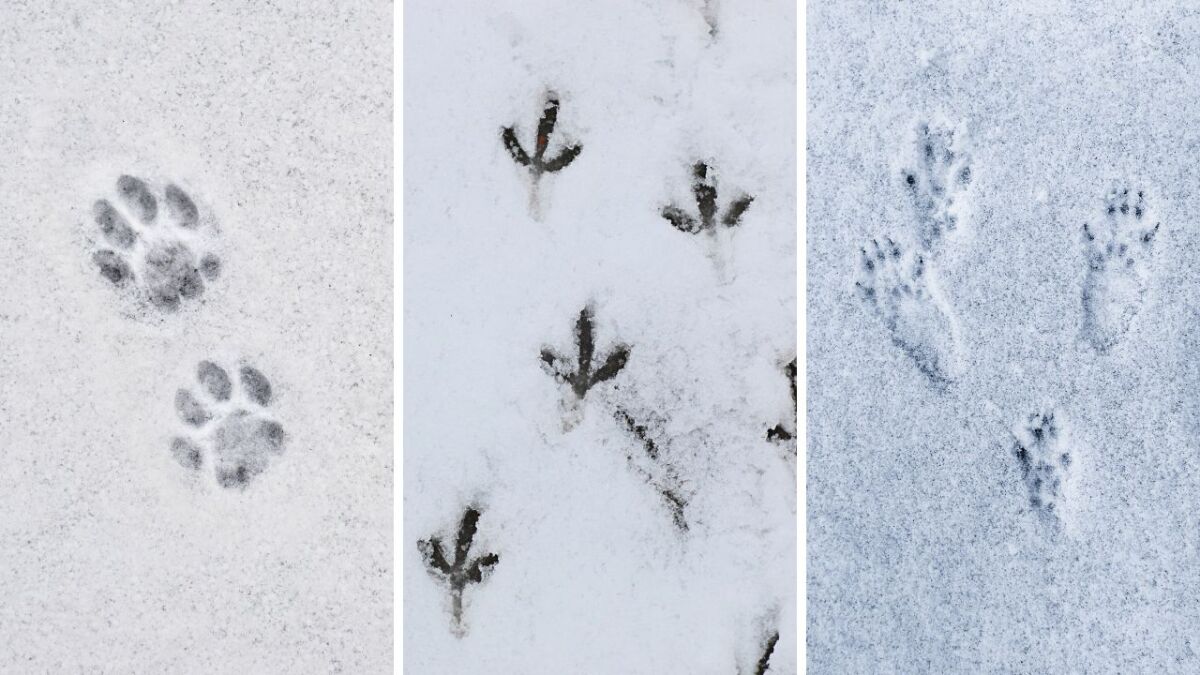
Recognizing and interpreting animal tracks in the snow in Germany: identifying prints, tracks, and trails (with pictures)
👉 The key facts from this guide
- You will find here a detailed insight into tracking with practical tips and recommended resources for beginners to advanced.
- The analysis of size, shape, number of toes, and track course helps to identify the responsible animal for the tracks.
- Specific signs of track imprints from various animals such as deer, wild boar, foxes, squirrels, and others are explained.
- The technique of tracking enables the interpretation of animal movements in the snow and the connection to nature.
- Erroneous information about animal tracks on the internet can lead to confusion; real practical experience from trackers is essential for correct tracking.
- The art of tracking is dynamic and challenging, but is deepened through practice and leads to a deeper understanding of nature.
Imagine you are walking through a freshly snow-covered forest. Everything is quiet, but suddenly, you discover something exciting in the snow - tracks.
Who ran here before you? A deer, a fox, or even a wild boar? But how can you tell the difference?
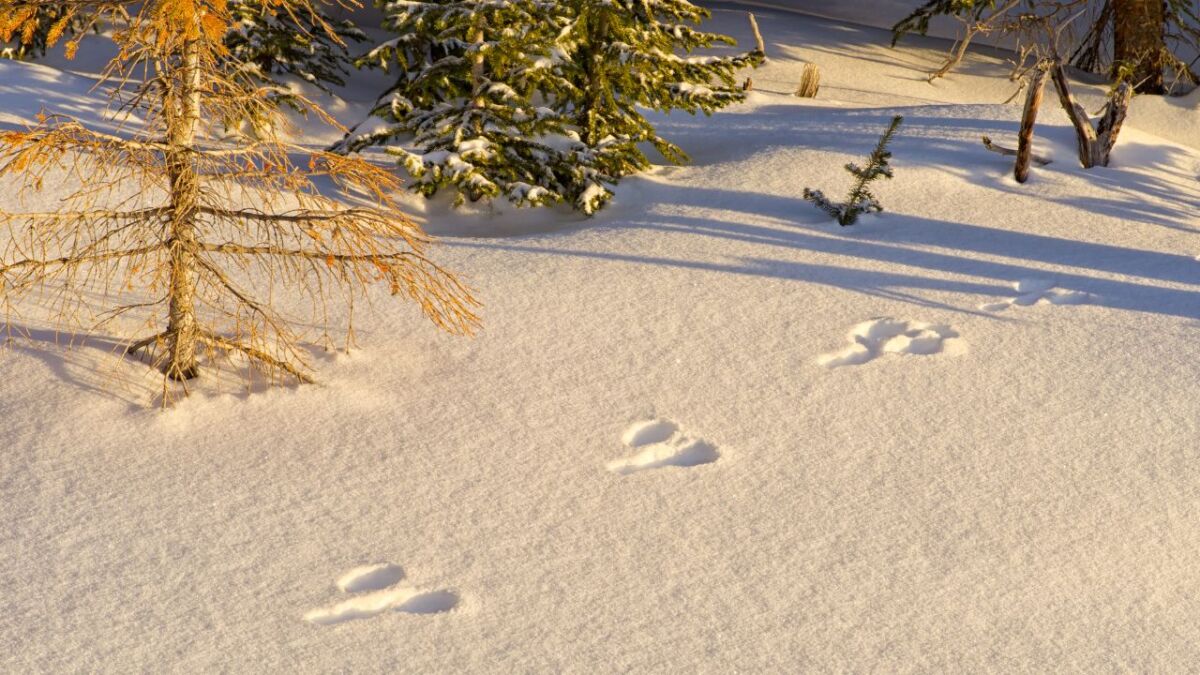
The problem is clear: You look at the tracks and it's like you're reading a foreign language. Confusing, isn't it?
I know the feeling, you are excited about the idea of getting closer to nature, but this mystery of the wilderness remains unsolved. Thoughts are swirling - what stories are hidden in these mysterious signs?
The solution is tangible: Tracking is the art that opens your eyes. It's like a key that helps you decipher the book of nature page by page.
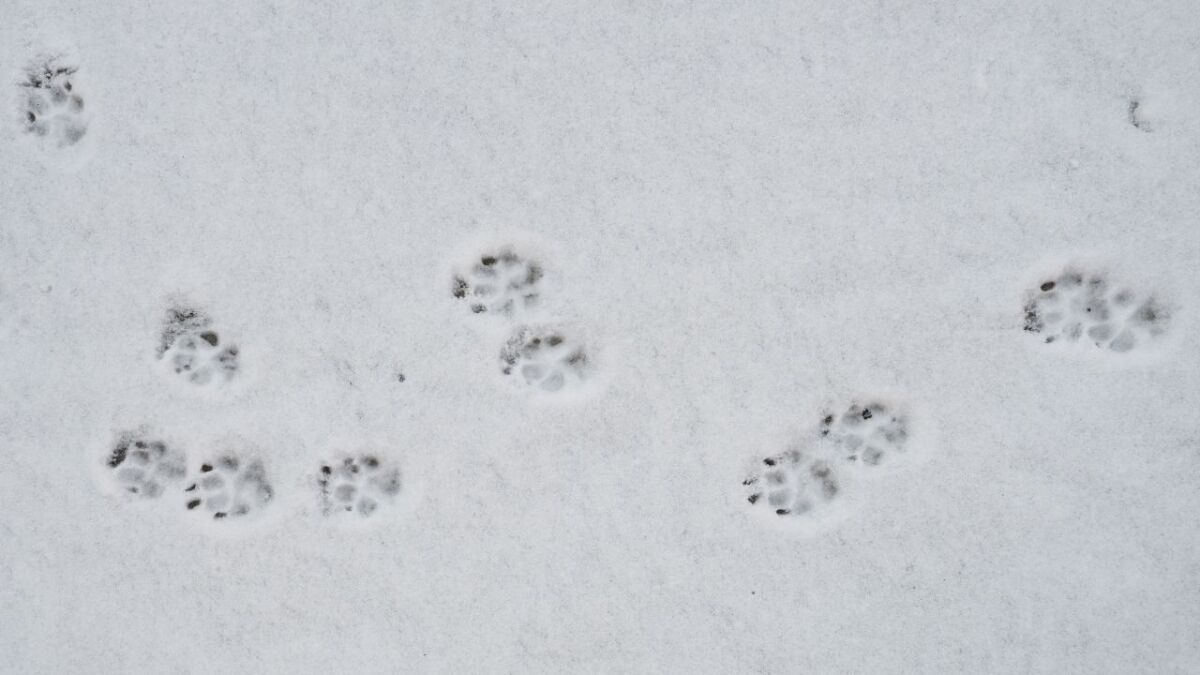
I take you by the hand today and show you how to read the tracks in the snow - simple and logical - with pictures from my camera and drawings from my pencil.
Soon you will not only recognize the tracks, but also understand what they tell you about the animal and its journey through the forest. Let's go, your adventure journey begins.
Connecting with Nature through Tracking
Hello, I'm Martin, and today I'm taking you on an exciting journey into the world of tracking in the snow.
For me, the forest is more than just a place - it is my second home, a place full of secrets and adventures.
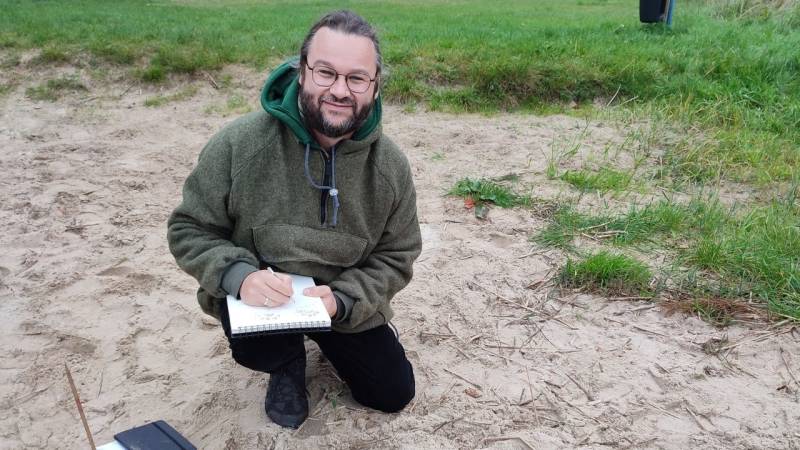
As someone who has completed their tracker training and has been practicing regularly for years, I want to share my enthusiasm and knowledge with you.
My journey started with a two-hour course in the park, then I moved on to a day course, and it ended with an intensive one-year training that taught me the fundamentals of tracking.
But learning never stops. I constantly educate myself, practice regularly, and delve deeper into the secrets of nature.
Various books help me with that, which I can highly recommend to you:
- "How to Learn Animal Tracking?" - a great starting point for beginners.
- "The Mammals of Central Europe: Observing and Identifying" - to get a comprehensive overview of the local wildlife.
- "Animal Tracks: Tracks | Feeding Signs | Droppings | Pellets" - ideal for beginners, affordable and comprehensive.
- "Animal Tracks of Europe: Identifying and Interpreting Tracks and Signs" - an absolute must-have for anyone who wants to seriously engage with the topic. With 1100 photos and 500 drawings.
- "Het prentenboek" - although in Dutch, it is comprehensive and detailed. Extensive manual with pictures of mammals, birds, invertebrates, reptiles, and amphibians. Suitable for use in Northwestern Europe. More than 700 photos and 350 drawings.
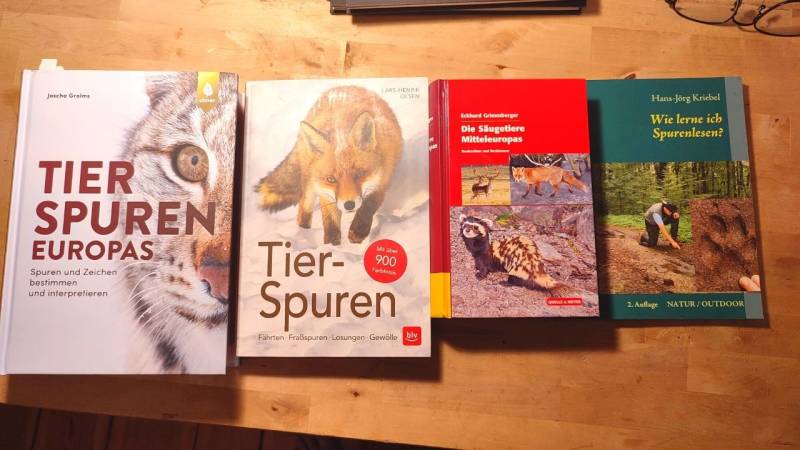
My secret tip:
👉 Get the field maps from extrabushcraft.nl. These maps are sturdy and well-crafted. Tracking becomes fun with them!
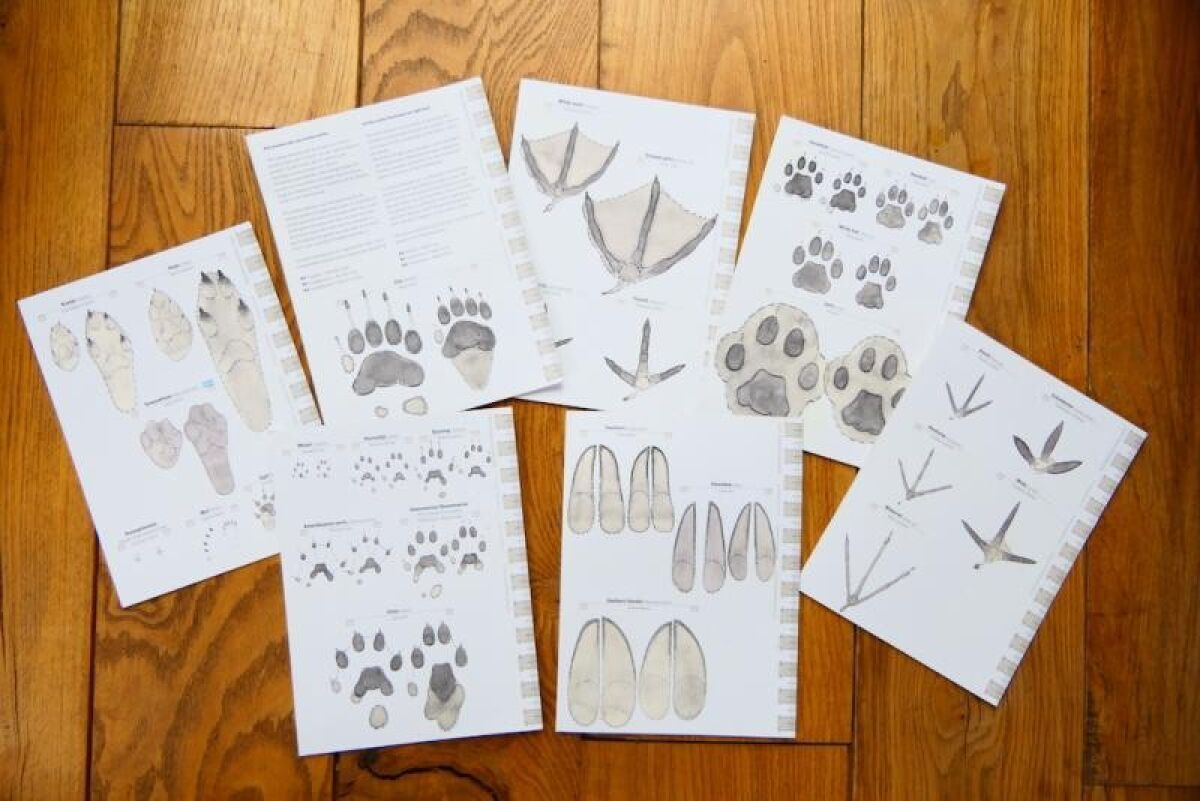
But books and maps are only part of the story.
The true magic of tracking is experienced outdoors, in the great outdoors.
When I wander through the forest, I feel alive. Every trail I discover is like a little puzzle to solve.
And believe me, there is nothing more fulfilling than deciphering the stories that animals leave behind.
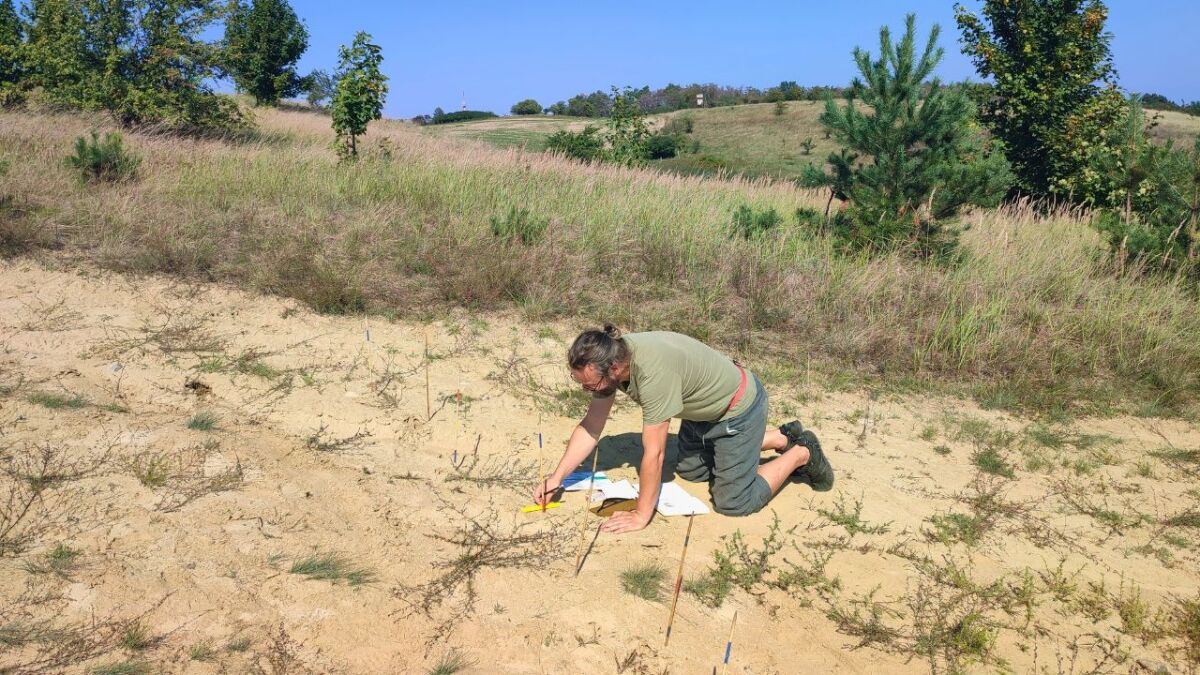
I now invite you to become part of my world.
Whether you are a beginner (here is my beginner's guide to tracking) just discovering your love for nature, or someone looking to strengthen their tracking skills - I am here to help you.
Let's explore the secrets of the wilderness together. The forest is waiting for us!
General characteristics - Recognizing animal tracks in the snow
When I wander through the winter forest, I see them everywhere: small and large footprints, a jumble of lines and patterns in the fresh white.
Every track in the snow is like a calling card of the wild animal that left it behind.
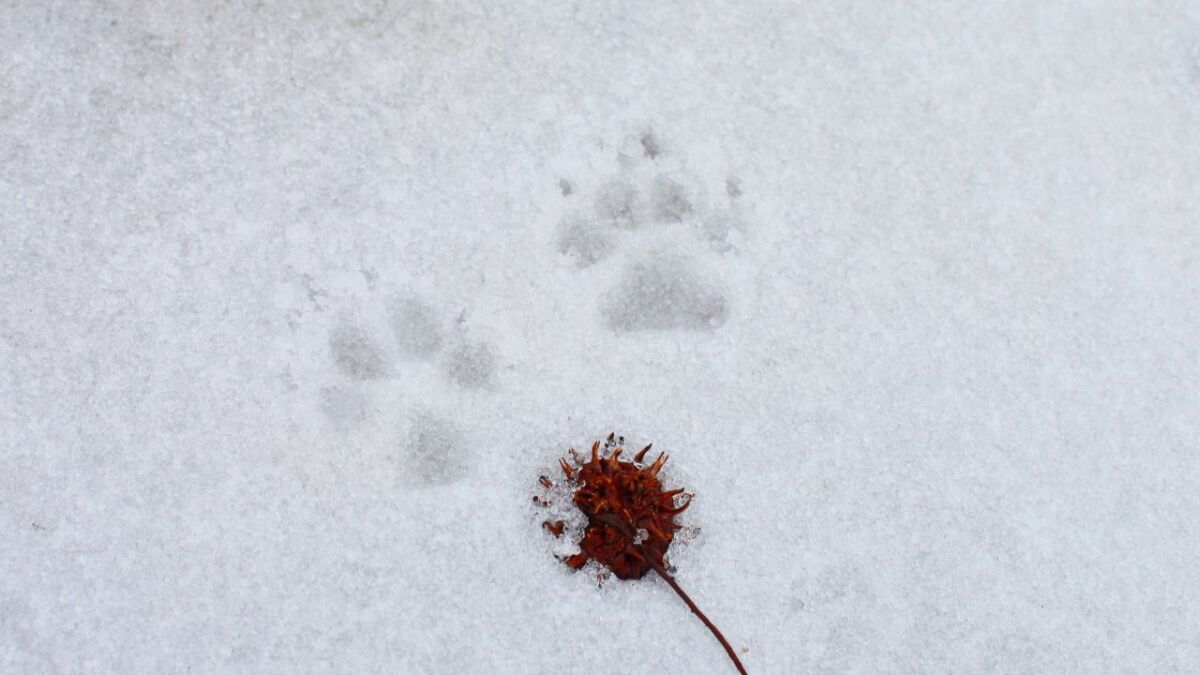
Here are a few things I almost always keep in mind to make reading easier for me:
- Size and shape: Tiny mouse tracks or the large imprints of a red deer - the size often provides the first clue.
- Number of toes: Four toes indicate a dog or a cat, five toes indicate a marten or raccoon, three often indicate a bird.
- Trail direction: Does the animal move in a zigzag, straight line, or does it jump? The gait reveals a lot about the species.
- Distance between tracks: Small animals take small steps, while large animals take correspondingly large steps.
I feel like I'm diving deeper into the world of the forest with every identified trail. It's as if I'm learning to speak the language of the animals.
Traces tell stories - about hunting, fleeing, daily survival. Reading them means understanding a piece of the forest.
I know it takes time to develop this perspective, but the more you practice, the more you learn to interpret the subtle signs. Soon, you will not only recognize traces, but also read the stories behind them.
Immerse yourself in this world, live at the moment and feel the connection that arises between you and the wild heart of nature.
Step-by-Step Methodical Tracking
When I stand in front of a fresh track in the snow for the first time, I start to think methodically.
I take a moment to take in the surrounding forest - the silence, the pure air, and then I focus on the trail ahead of me.
And here is my step-by-step guide on how I proceed.
Understanding Animal Tracks - The Handwriting of Wildlife
First, I take a close look at the footprints. But what is a footprint?
Footprints are the imprints that animals leave with their "hands" and "feet". The word is widely used in tracking.
Here are the key questions I ask myself:
-
How many toes are present? I count the toe prints - they are the first relevant clue.
-
Are there claws, webbed feet, or hair visible? Claws can indicate a marten, webbed feet can indicate a beaver or waterfowl, and visible hair can indicate animals like foxes or rabbits.
-
What shape is the footprint? Oval, round, rectangular - each shape has its story.
-
Is the footprint symmetrical or asymmetrical? The symmetry tells me a lot about the animal's family.
-
How long and how wide is the footprint? The dimensions lead me to the specific species.
After careful observation and analysis of these characteristics, I usually list 3 animals that could be possible candidates. This approach helps me to come up with a conclusion or an idea.
When you start reading tracks, a new world opens up. You become a witness to the invisible life in the forest.
And now let's get started with the first animal. You're probably already excited and want to compare tracks.
Traces of the deer in the snow - the signs of the forest
I remember vividly the first time I discovered the delicate imprints of a deer in the snow.
They were elegant, almost delicate, a beautiful reflection of the graceful essence she had left behind.
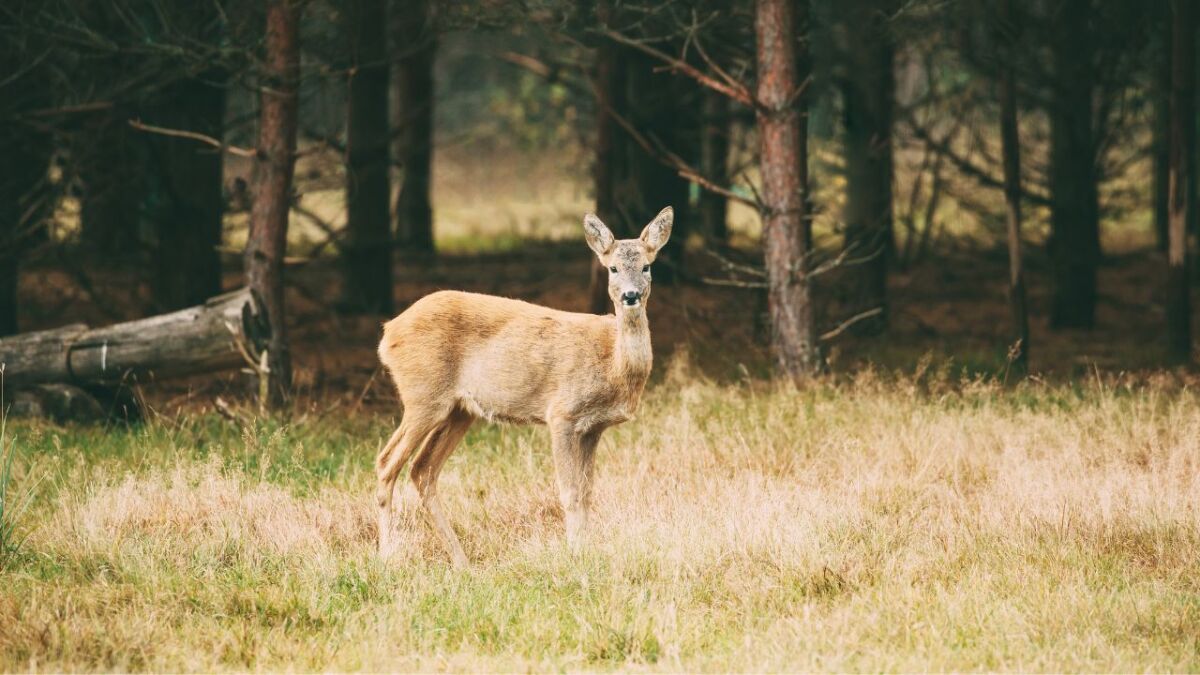
Optimally, the footprint of a deer looks like this:
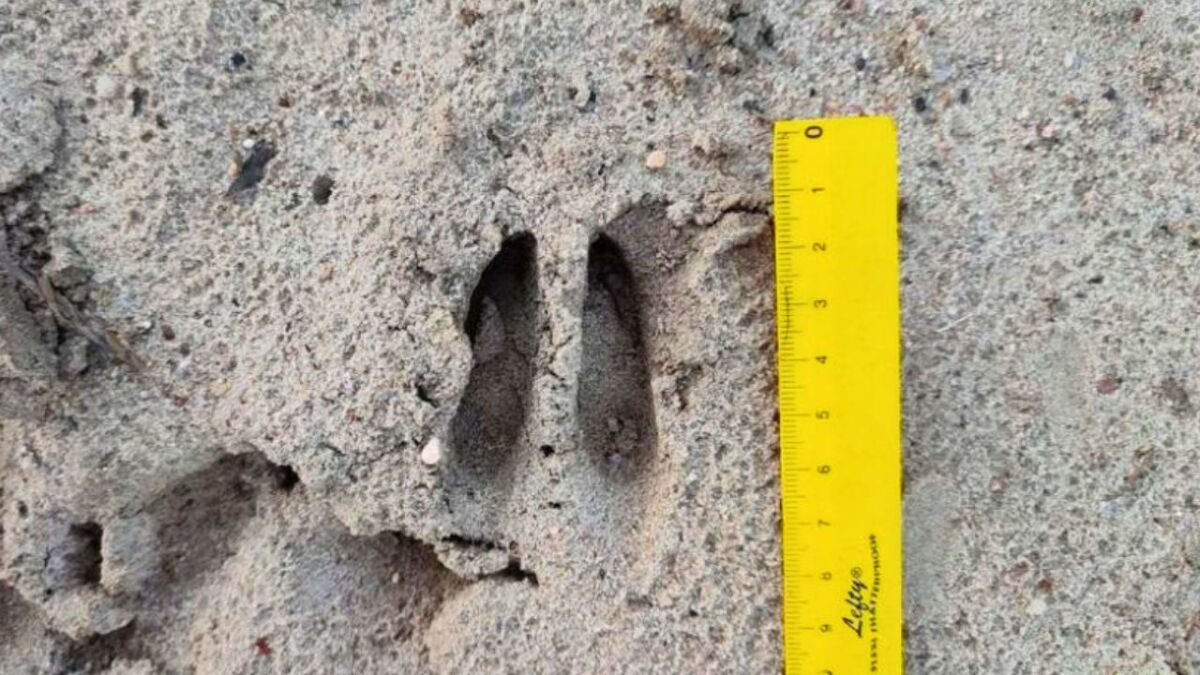
In the snow, it can look like this:
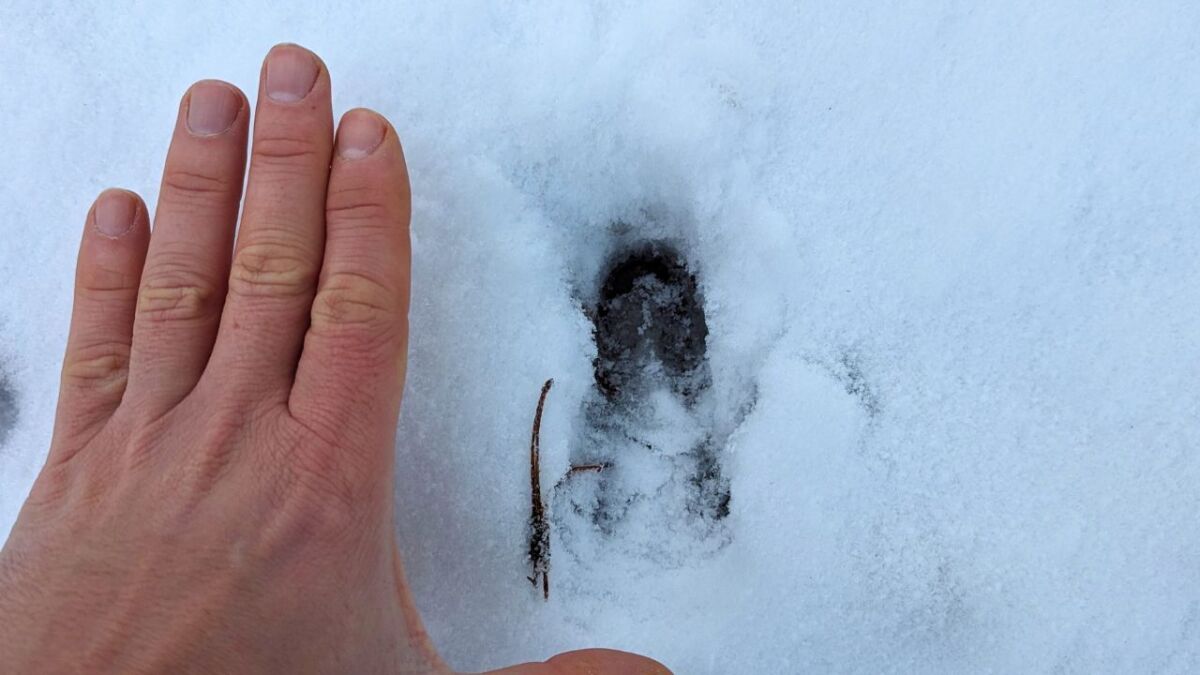
Here is a short video about the footprint of a deer in the snow (in German):
Characteristics of deer tracks (hoofed mammals)
Deer tracks have special characteristics on the snow cover that distinguish them from other animal species. Let's explore these features together:
- Number of toes: Deer have two hooves that taper sharply (they are cloven-hoofed). However, they have a total of 4 toes. Toes 2 and 5 are greatly reduced - these are called dewclaws (located on the back of the foot).
- Claws: Claw imprints are not visible in deer tracks, only the hooves are visible.
- Webbed feet or hair: Neither, the deer is a cloven-hoofed animal without visible webbed feet or hair in the track.
- Shape of the track: Deer tracks are often heart- or kidney-shaped and quite slim and elongated.
- Symmetry: The tracks are slightly asymmetrical, with a clear separation (a ridge) between the toes.
- Size: Deer are toe walkers.
- Front: 3.1-6.3 cm long and 2.5-5.4 cm wide
- Back: 3-6 cm long and 4.2-5.4 cm wide
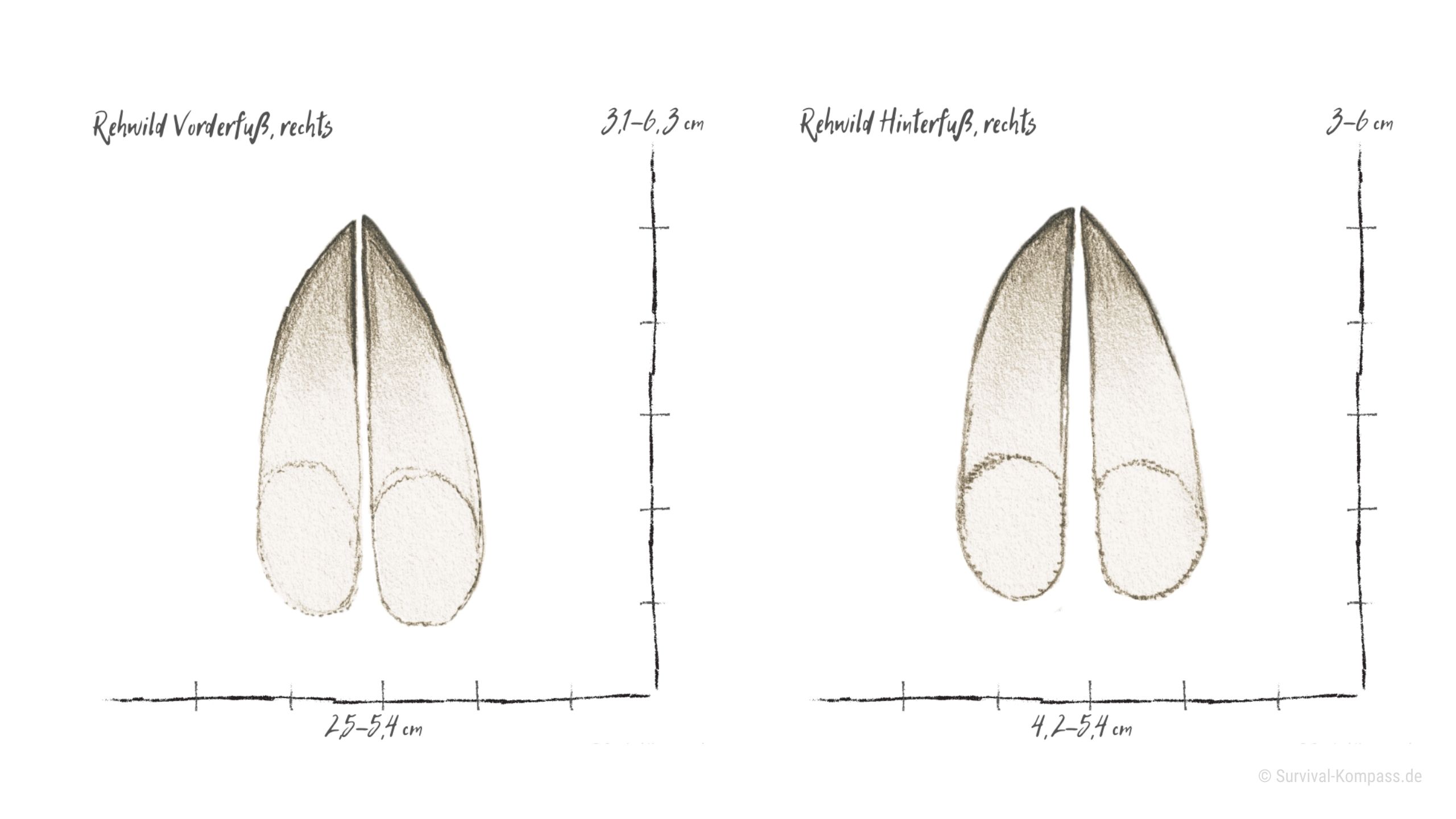
Below you can see the shells and below them the hind claws.
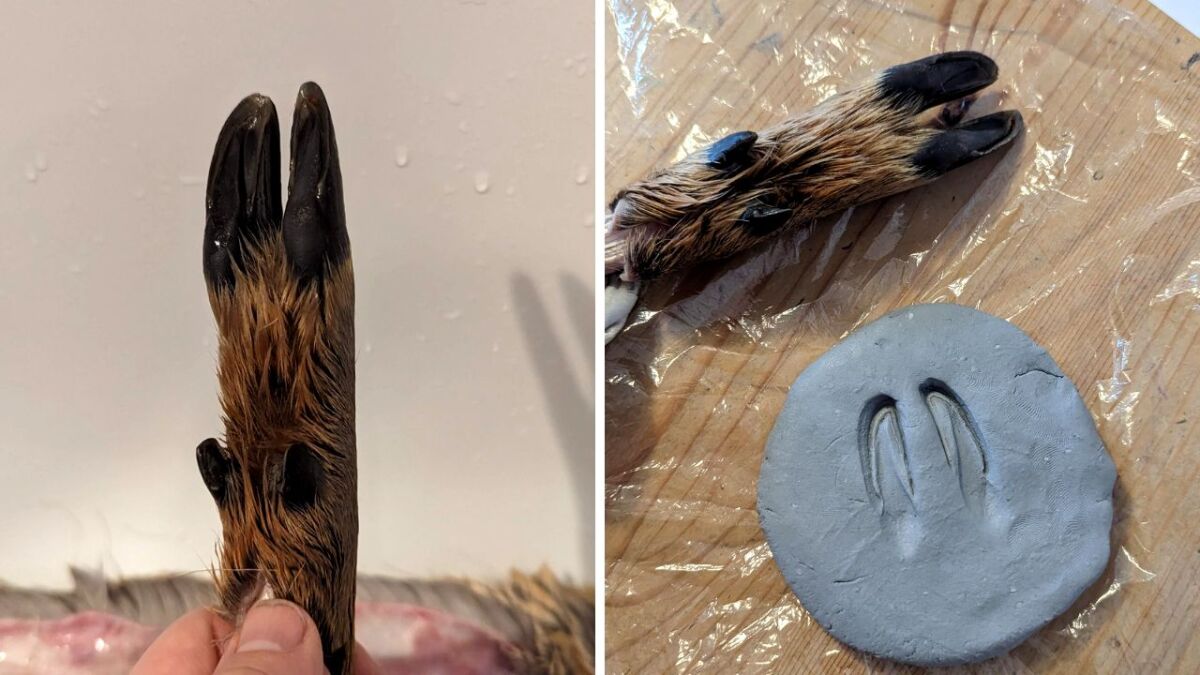
Special Features and Risks of Confusion
A beginner could easily mistake deer tracks for those of wild boar piglets, but pay attention to the size: deer tracks are longer and not as wide.
In addition, sometimes the dewclaws break off and they are located right behind the hooves (in wild boars, they are located on the sides of the outer edges of the hooves).
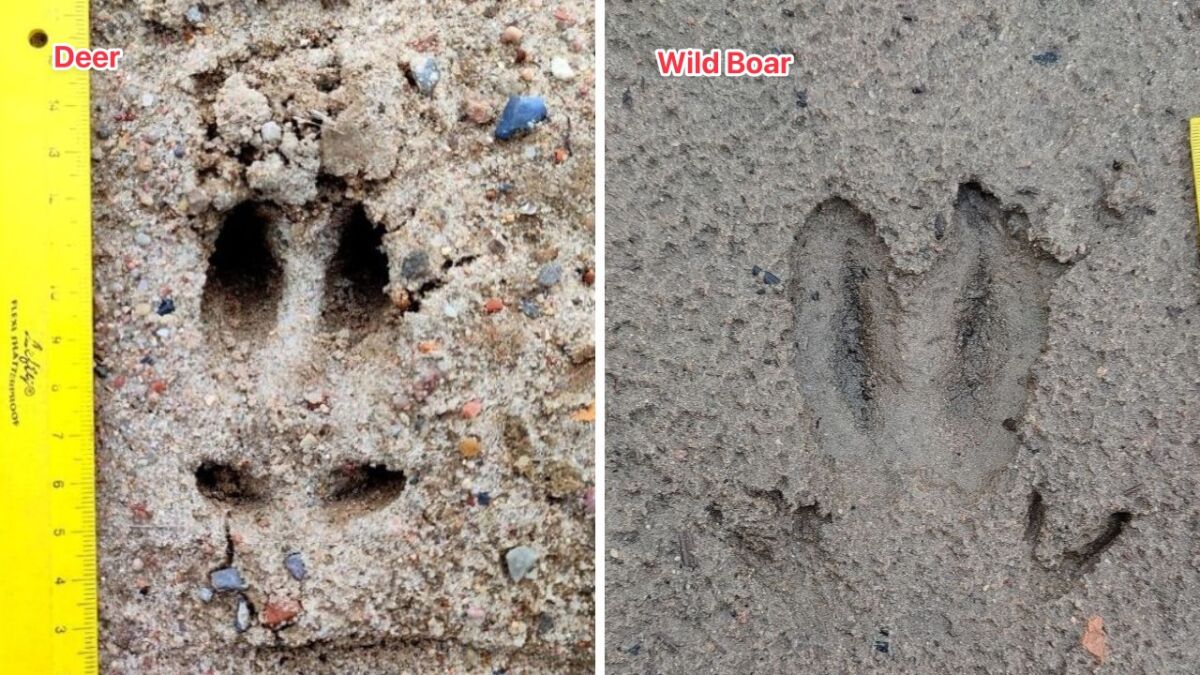
If you compare the heart-shaped deer tracks with the broader and rounder imprints of a wild boar, you will quickly notice the difference.
Learn to read the delicate drawings in the snow and feel the closeness of these beautiful creatures. For a deeper insight, take a look at my animal tracks database, where you can learn even more about the traces left by deer.
Discovering deer tracks in the snow is like finding a silent greeting from another world.
I also have a video (in German) for you where I show you the difference between roe deer and wild boar.
Now let's move on to another animal - the wild boar!
Recognizing traces of wild boar in the snow - evidence of the hoofed animal
One morning, deep in the forest, I came across a trail that looked like a wide path in the snow.
The tracks were significantly larger and more robust than any others - signs of wild boars. It is impressive how these strong animals shape the ground.
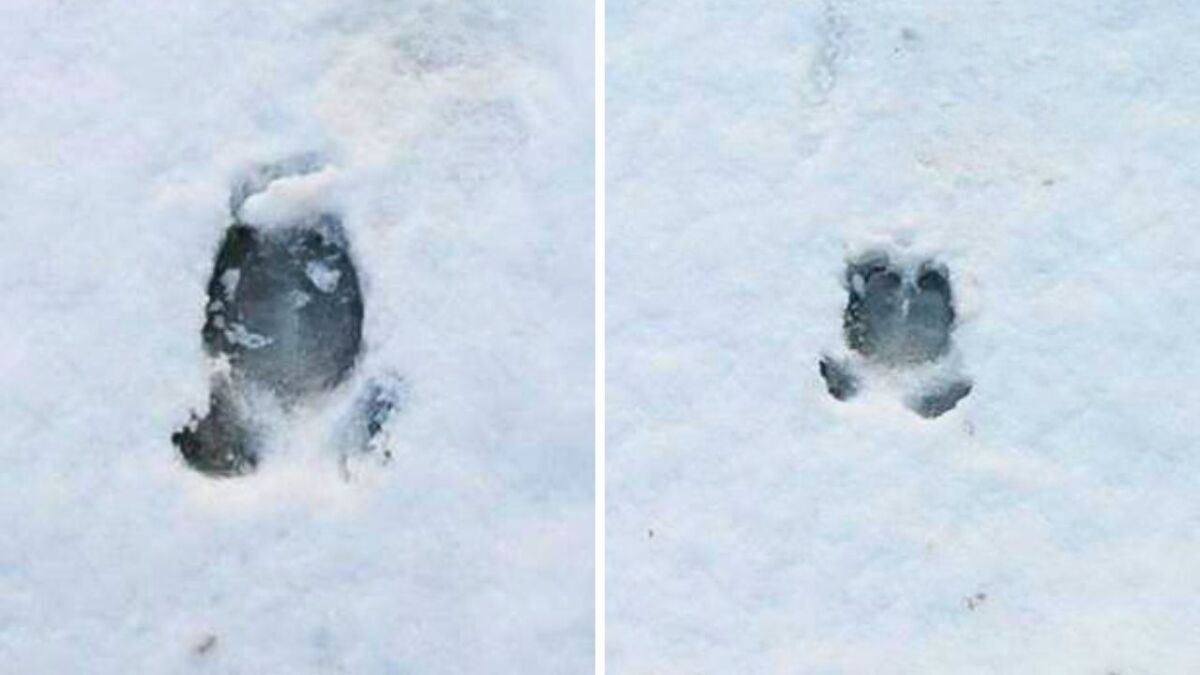
Characteristics of the Wild Boar Footprints
With wild boars, we are dealing with true powerhouses, whose tracks exhibit characteristic features.
- Number of toes: Typically two hooves that leave large imprints in the snow. But a total of 4 toes. 2 toes that always leave imprints and 2 toes - the dewclaws - that are located at the back of the leg (usually recognizable).
- Claws: Wild boars do not have claws.
- Webbed feet or hair: Not present, like most ungulates.
- Shape of the track: Wild boar tracks are generally oval to almost round. So as wide as they are long.
- Symmetry: Slightly asymmetrical. Compared to deer tracks, wild boar tracks are wider and the separation between the main toes is less pronounced. Often only a wedge is visible at the top.
- Size: Wild boars are toe walkers with medium-sized feet.
- Front feet are 5.1-6.6 cm long and 4-7.6 cm wide
- Back feet are 4.8-6.2 cm long and 4.2-6.9 cm wide
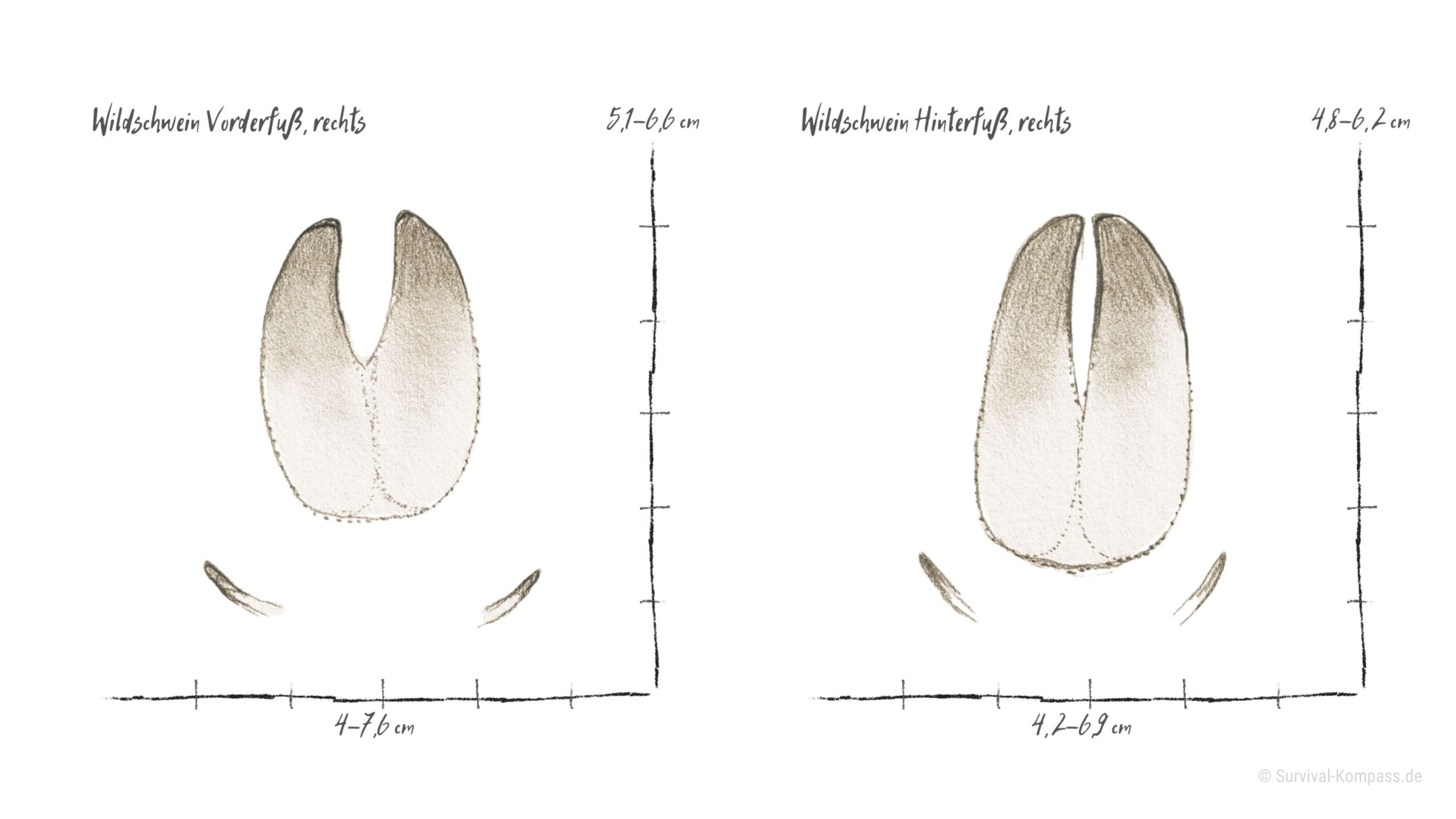
Differences from other ungulates
When compared to other ungulates such as roe deer, fallow deer, or red deer, the wild boar's larger hoof prints stand out.
Their tracks are not only wider, but also rounder, which is a clear difference from the slim and pointed tracks of the deer.
A wild boar leaves more than just a trace - it leaves an impression of unstoppable power and wildness.
Special Features and Risks of Confusion
Pay attention to the two small toes (dewclaws) at the back and sides of the hooves, which are often visible, especially on soft ground or deep snow. They are a clear distinguishing feature, as you rarely see them on deer - but almost always on wild boars.
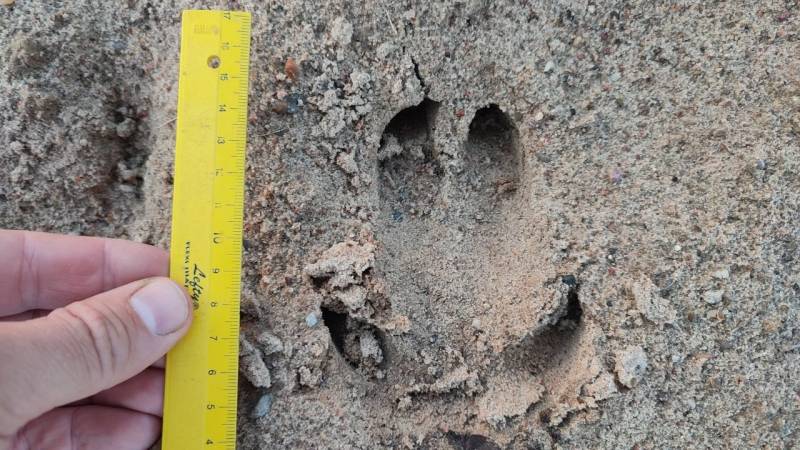
The fascination that emanates from the traces of wild boars is indescribable to me. They tell of the strength and adaptability of these wild animals.
For deeper insights into the world of wild boar tracks, visit my wild boar animal tracks database. There you will find all the information to become an expert in tracking on your next expedition.
Identifying Fox Tracks in the Snow - Discovering the Cunning Ones
As I wander through the frosty morning, sometimes the quiet witnesses of the night reveal themselves: fox tracks.
Their appearance is captivating, they reveal the skill and cleverness of their creators.
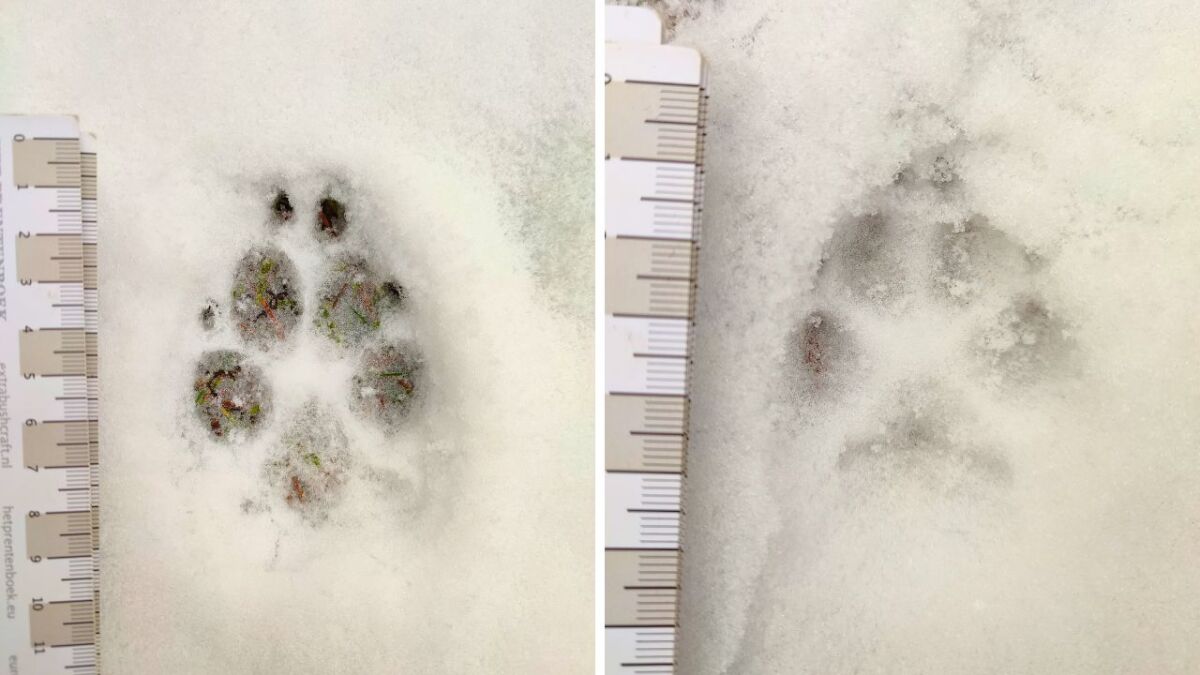
Characteristics of a fox track
Recognizing the tracks of a fox has something magical for me. They are delicate and precise, evidence of the elegance with which the fox moves.
- Number of toes: A fox has four visible toes imprinted in the track. However, it actually has 5 toes (toe 1 greatly reduced and high up on the leg).
- Claws: Unlike cats, foxes often have visible claws.
- Webbing or hair: No webbing, but sometimes hair can be seen around the track.
- Shape of the track: Fox tracks are oval with a slightly rounded hind edge.
- Symmetry: The tracks are symmetrical as the toes are almost all the same size.
- Size: Large, heavily furred feet. Front feet are larger than hind feet.
- Front: 4.8-7.2 cm long and 3.6-5.7 cm wide
- Hind: 4-6.2 cm long and 3.1-4.6 cm wide
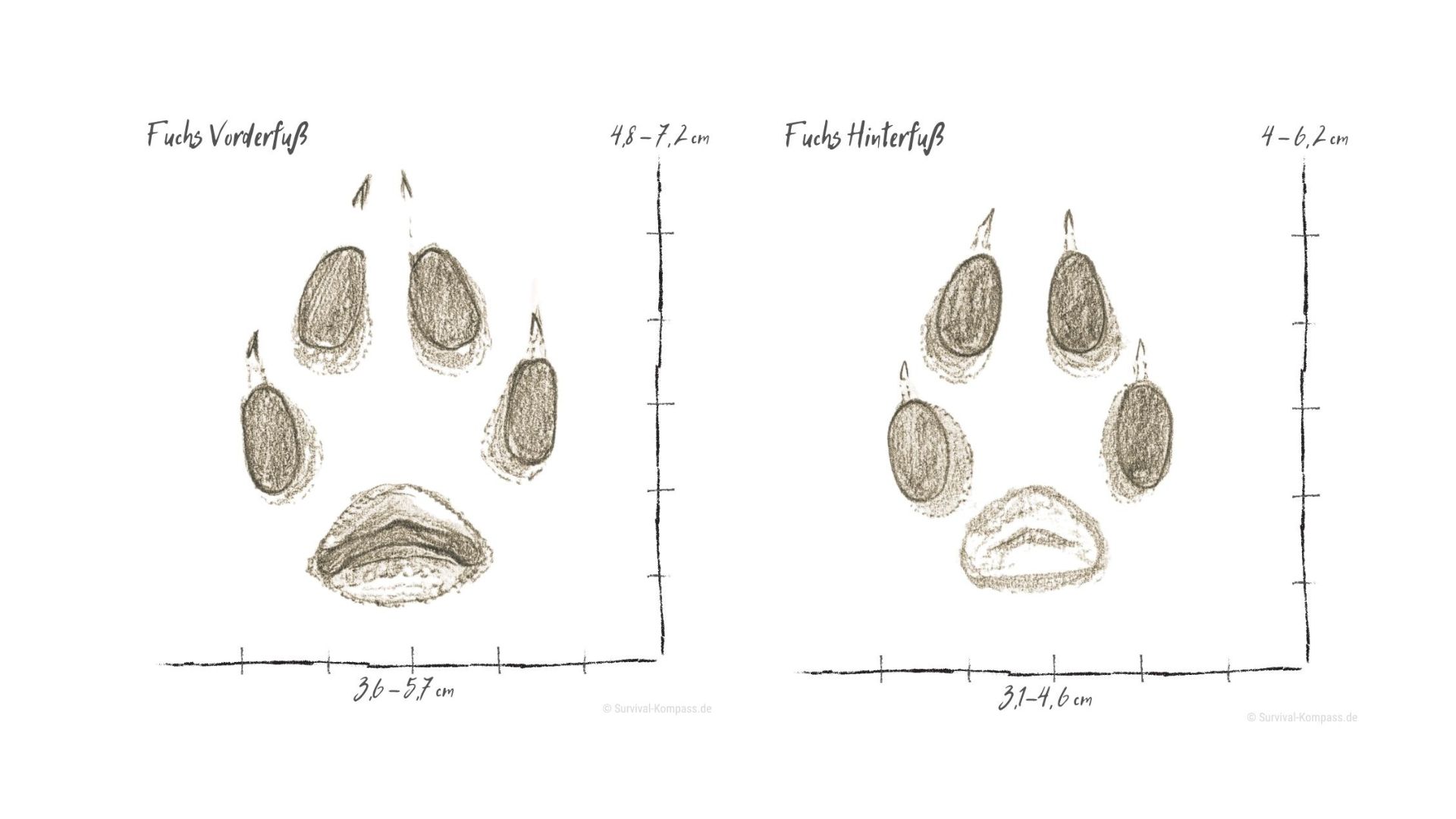
Special features and dangers of fox tracks
Fox tracks can easily be mistaken for dog tracks, but look closely: fox tracks are slimmer and the toe imprints are closer together. The gait is often much more purposeful than that of aimlessly wandering dogs.
Traces of a fox are like signatures in the snow, each one unique and full of life.
Here are two distinct characteristics:
👉 First: On the forefoot, there is often a line, a bar, or a slightly curved line in the midfoot area. If you see this, it's a fox.
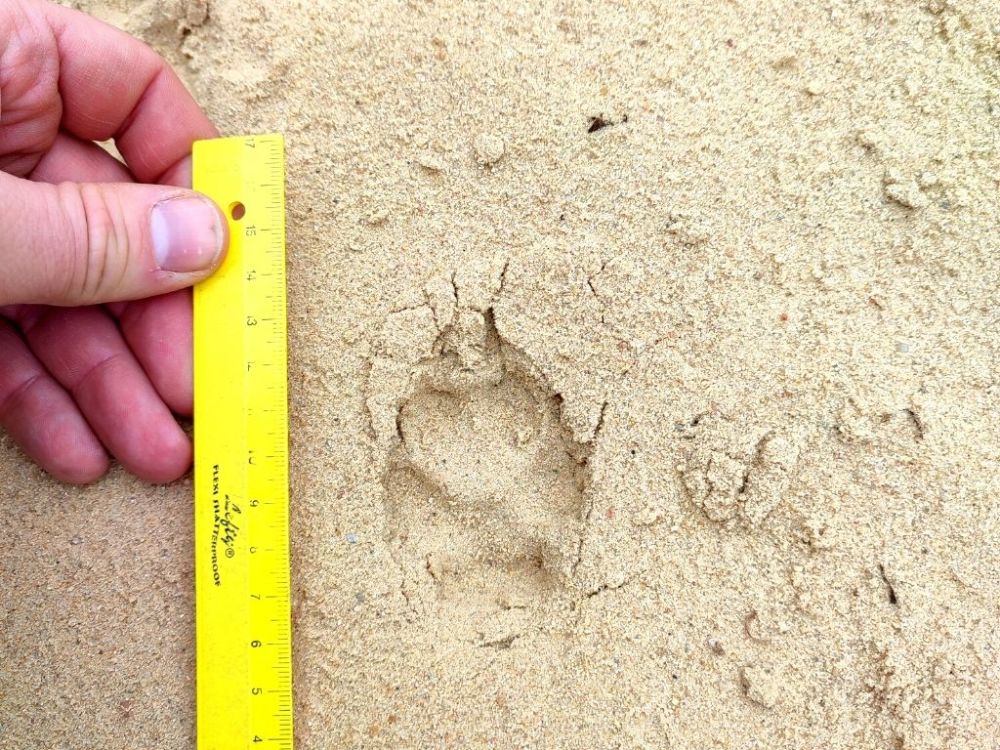
Here are the details about the bar:
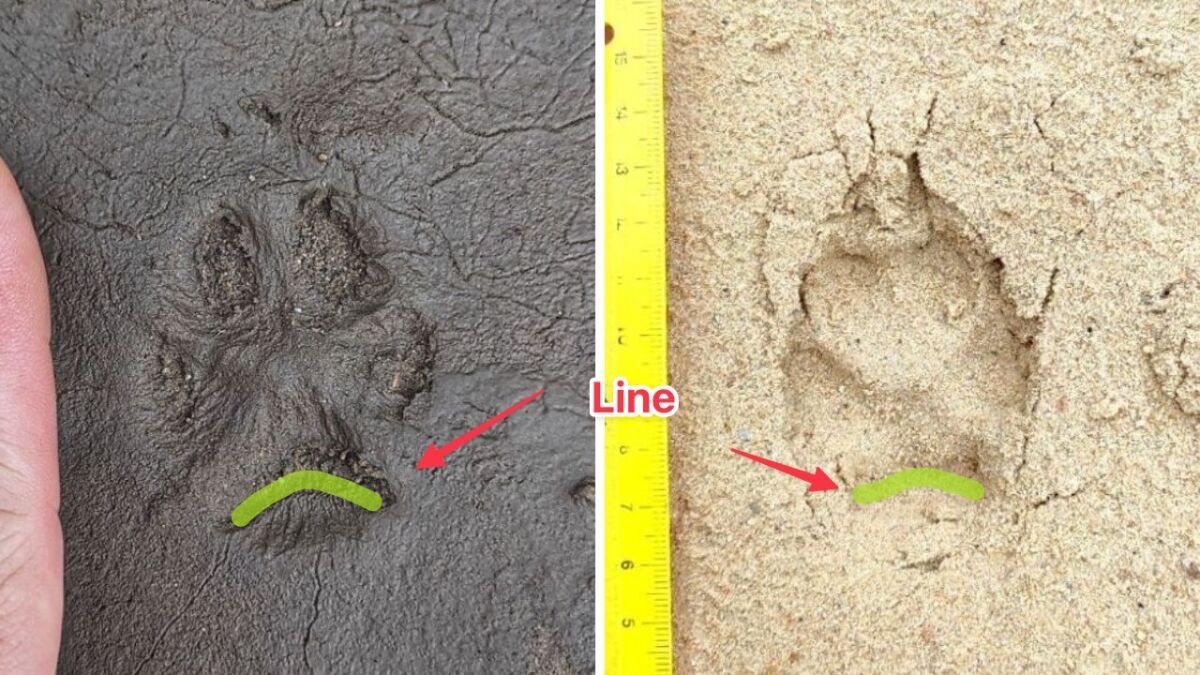
👉 Second feature: Try to imagine a line between the inner toes (the two in the middle) and the outer toes (the toes on the left and right sides). In dogs, this line runs clearly into the outer toes when you start below the inner toes - in foxes, it stays at the edges.
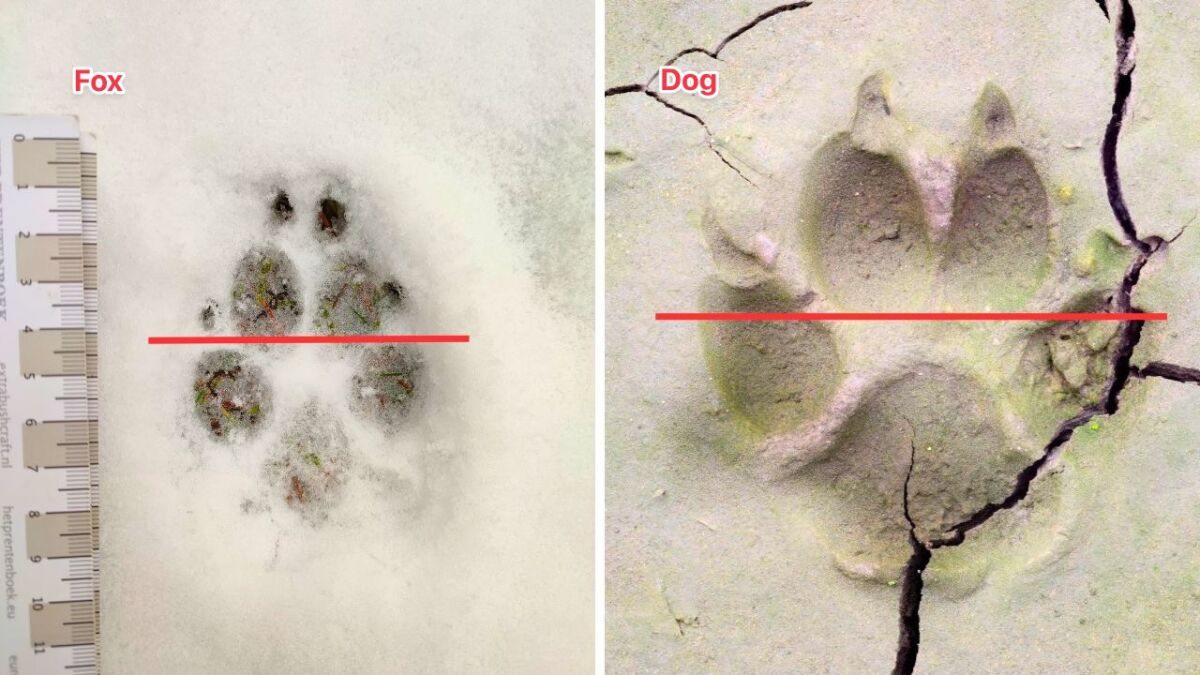
Characteristic gait of the fox - The fox's track pattern can resemble a string of pearls
The fox has a special gait, the trot, in which the hind footprints step exactly into the front footprints.
It looks like only a pair of feet have touched the snow. With a little imagination, this looks like a string of pearls: pearls strung on a string. The trackers also call it lacing.
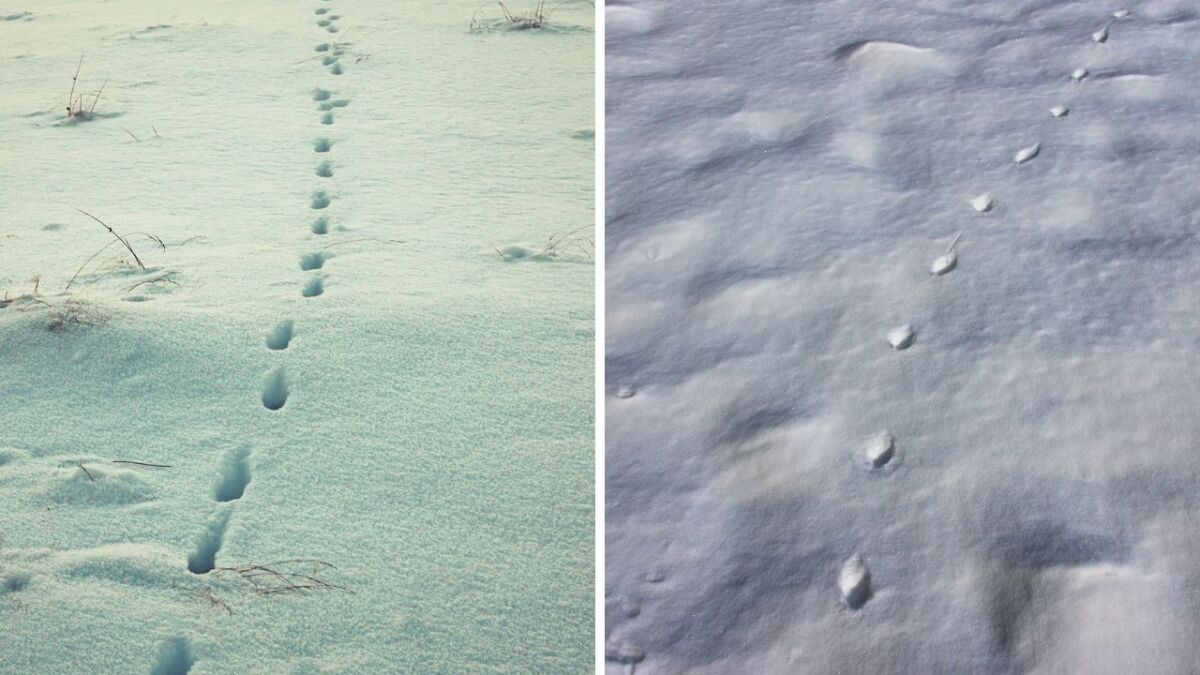
Tracking is a silent art, and discovering fox tracks is like flipping through an exciting book. I wish you many of these valuable encounters, and if you are keen to learn more, here is my animal track database with fox tracks that shows you how to track the cunning ones.
Traces of the Squirrel - Acrobatics in the Snow
It's early in the morning, the snow crunches under my boots, when suddenly small, regular footprints catch my attention.
I bend down and smile - squirrels were here, their tracks are like dots and dashes in the snowy dress of the forest.
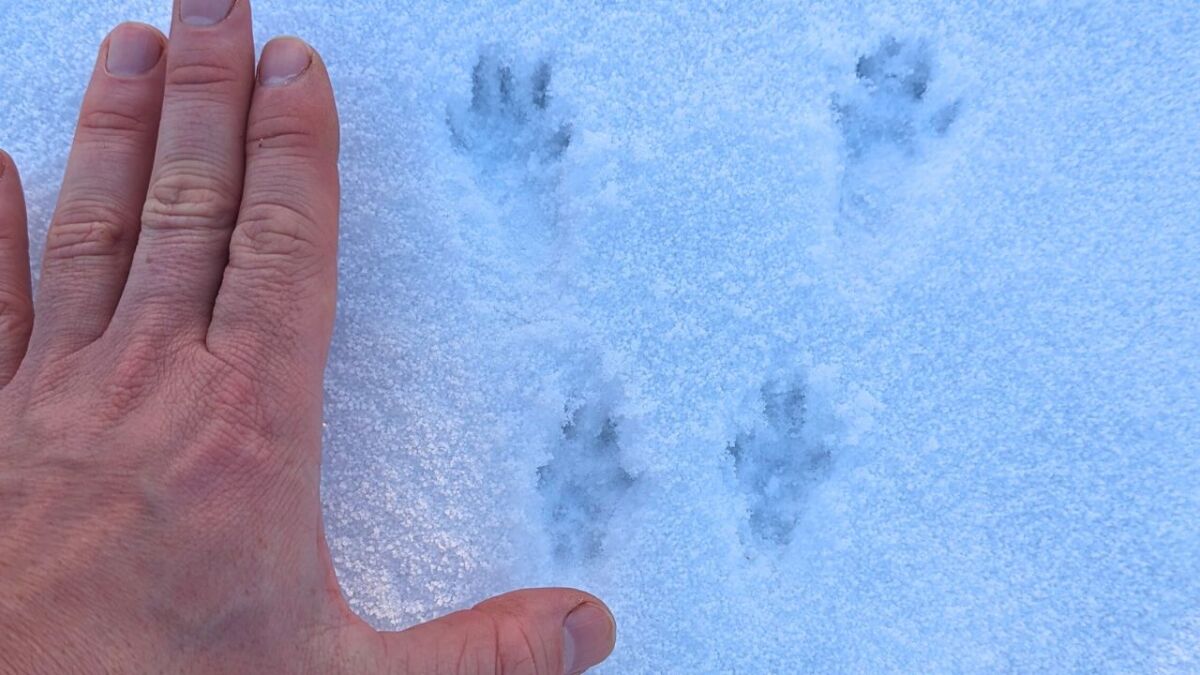
Unique Features and Size
The lively hoppers of these tree-loving acrobats leave distinctive traces. Here's what I notice:
- Number of toes: In the front, you can see 4 small toe prints, but there are actually 5 toes. Toe 1 is greatly reduced and never visible. In the back, you can see 5 toes.
- Claws: Mostly recognizable fine and sharp prints, as squirrels need them for climbing.
- Webbing or hair: No webbing or hair in the print.
- Shape of the track: If visible, the hind footprints are longer than the front footprints.
- Symmetry: Due to the different size of the front and hind feet, the pattern appears asymmetrical.
- Size: The tracks are small, squirrels are plantigrade.
- Front: 3-4.8 cm long and 1.5-3.5 cm wide
- Back: 3-6 cm long and 2.3-4.5 cm wide
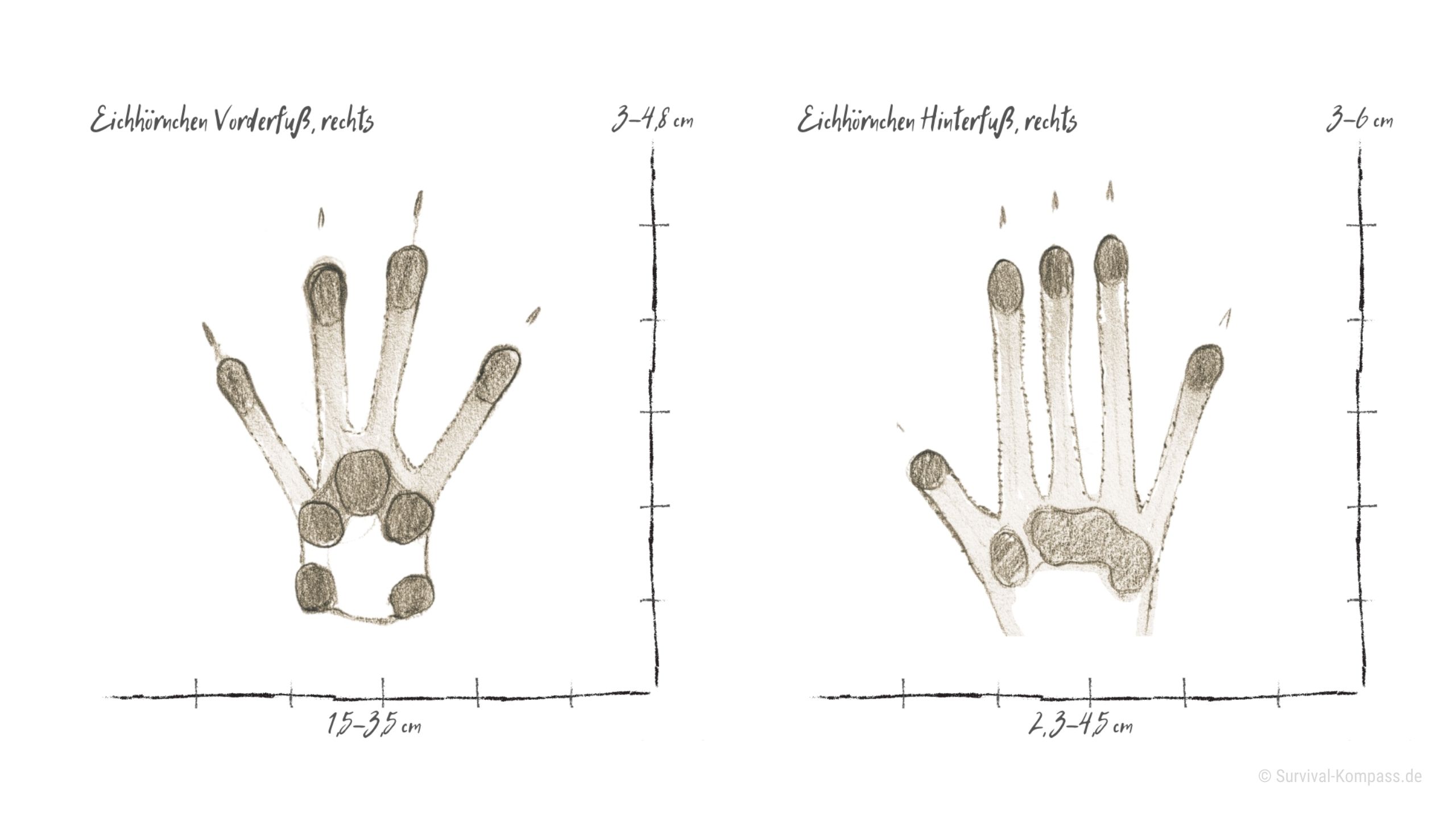
Here I have another video (in German) for you about squirrel tracks in the snow:
Squirrel tracks are the periods and commas in the poetry of the forest, signs of the light life in the branches.
Special Features and Risks of Confusion
The track of the squirrel is almost unique. The front feet land first and then the hind feet on top, leaving a four-part pattern (like a V) in the snow. Don't confuse them with those of a rabbit - their tracks are much larger and further apart.
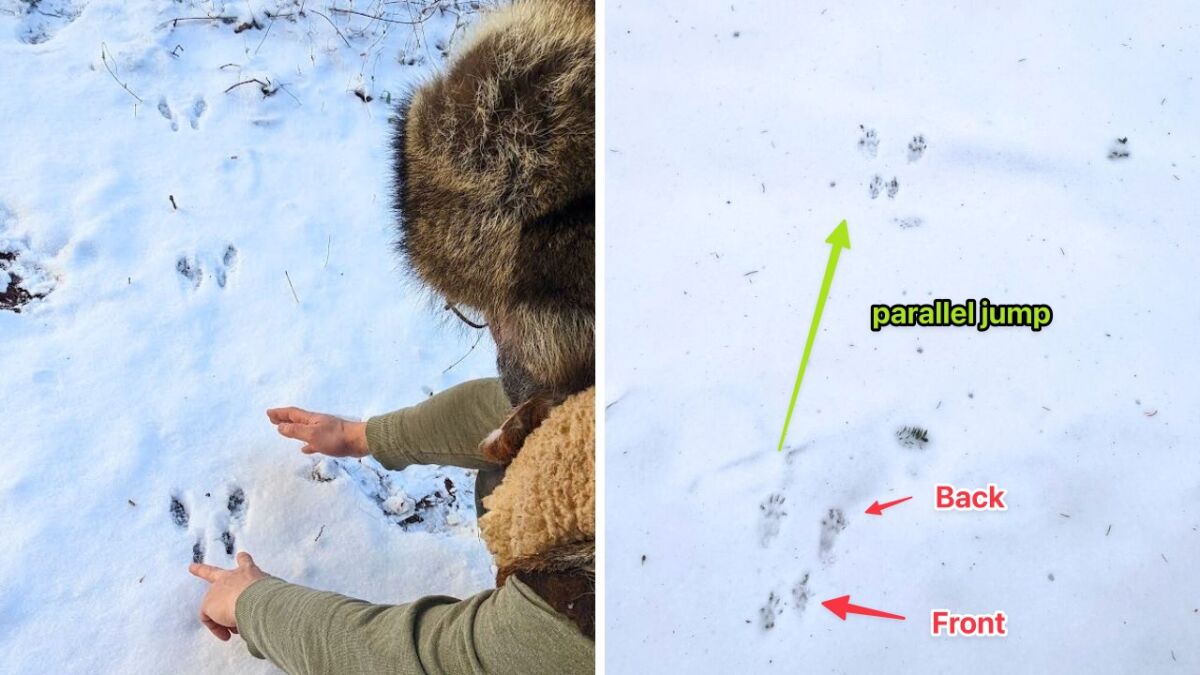
Tracking the dances of squirrels in the snow is a true pleasure. Their tracks tell of energy and cheerfulness.
Do you feel like discovering the tracks of these agile climbers yourself? Take a look at my animal tracks database, where you will find all the details to discover them on your excursions.
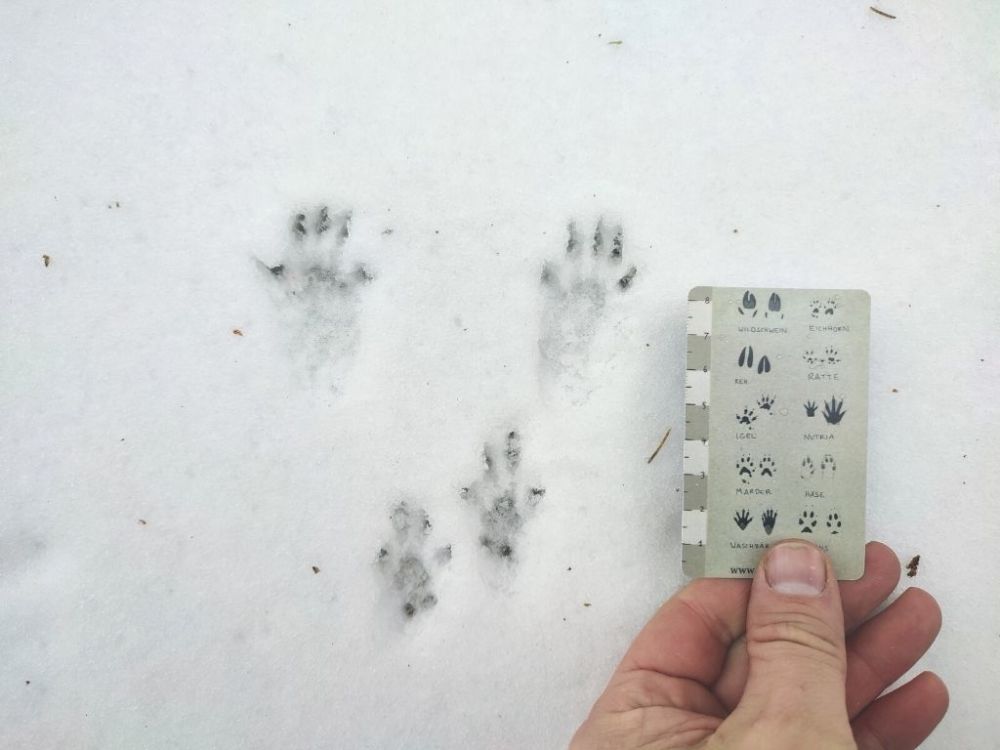
Rabbits in Detail - These Tracks in the Snow You Will Find
Imagine you are outside in the white winter forest. Everything is quiet. You breathe in deep, fresh air. And then you see them: small footprints in the snow.
A sign of life amidst the silence. Rabbit tracks! But how do you recognize them exactly? Come, let me show you how it's done.
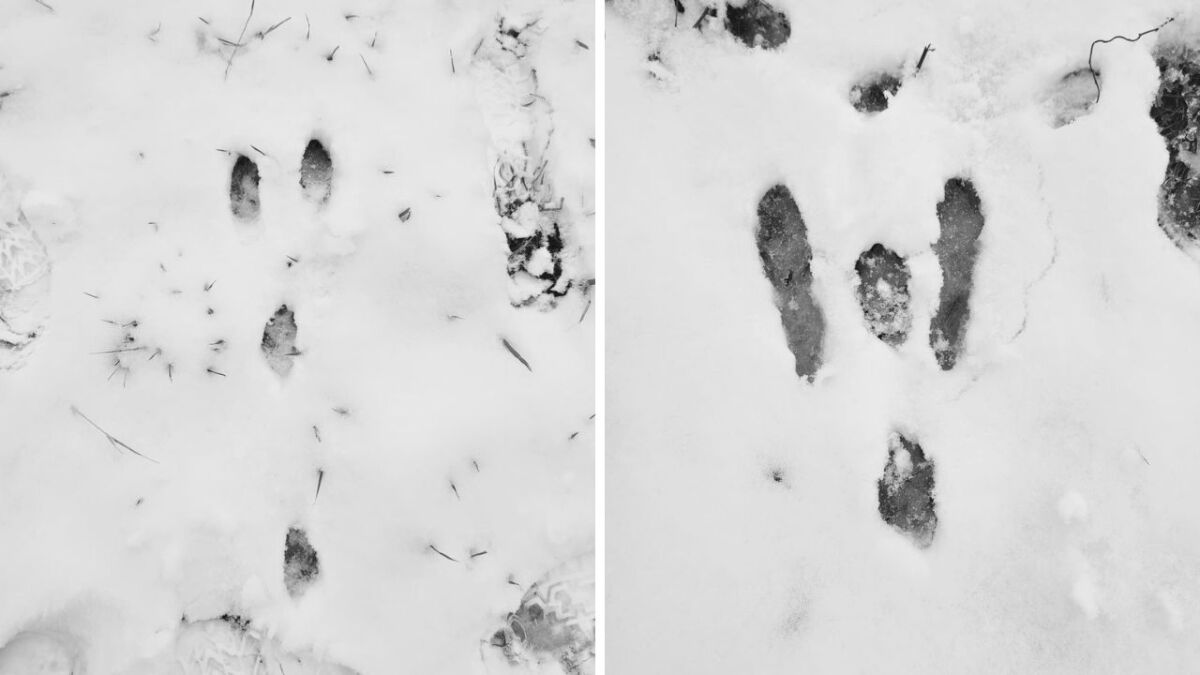
Unique characteristics and size of rabbit tracks in the snow
Recognizing rabbit tracks is a fascinating puzzle. Here are the pieces:
- How many toes? Rabbits have four toes on their hind legs and five toes on their front legs. The first toe on the front is greatly reduced and often not visible.
- Claws, webbed feet, hair? The strong claws are often visible, no webbed feet, but sometimes you can see fine hairs in the snow.
- Shape of the track? The imprints of the hind feet can be much longer. Oval shape in the front and back.
- Symmetry? Rabbit tracks are strongly asymmetrical in the front and slightly asymmetrical in the back.
- Size? The hind feet are impressive: about 10 cm long.
- Front feet: 4-7.5 cm long and 2.5-7 cm wide
- Back feet: 4.5-9 cm long and 3.2-9 cm wide
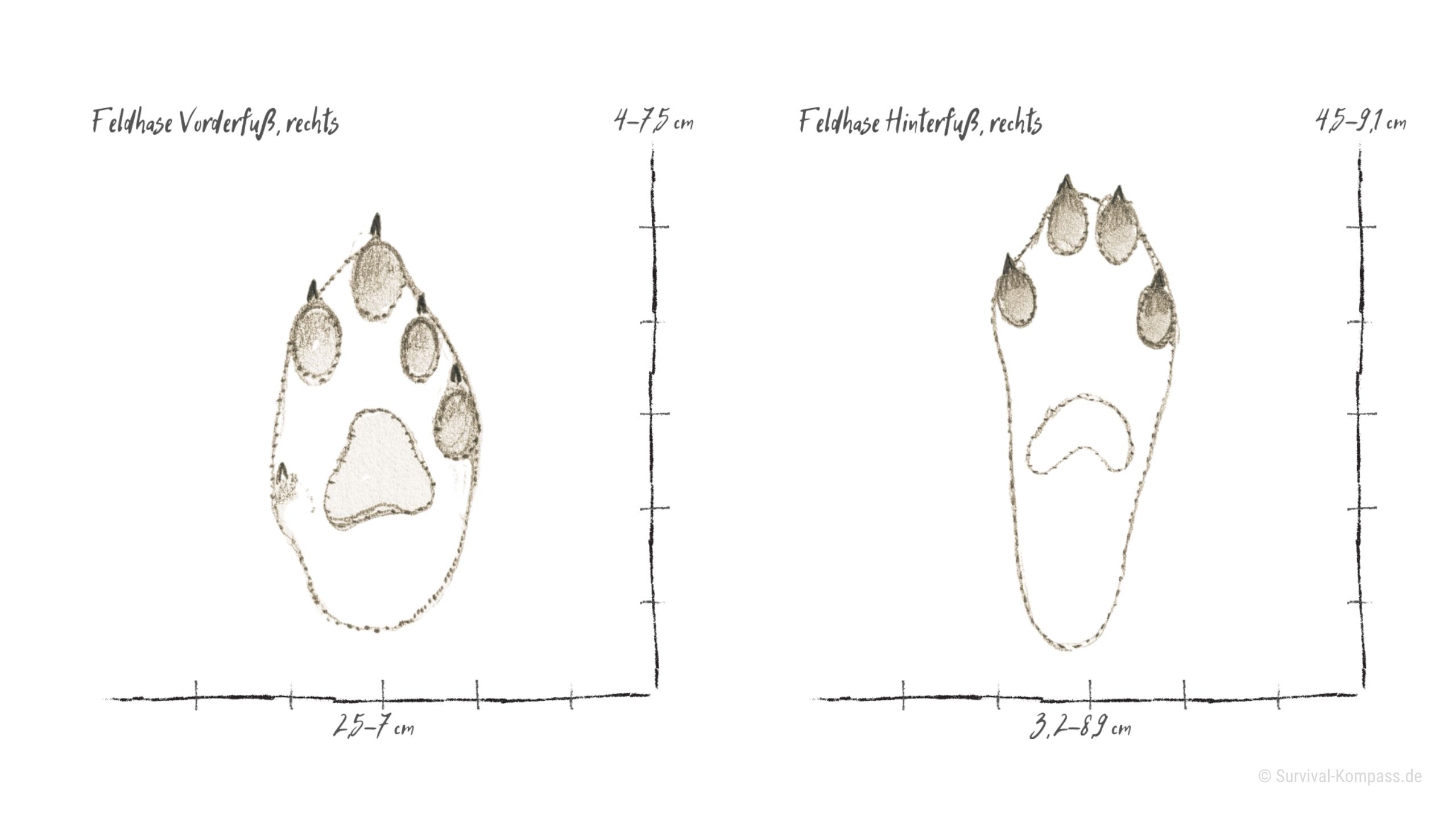
Here is a picture of the paw print in the sand - you can see the claws well there:
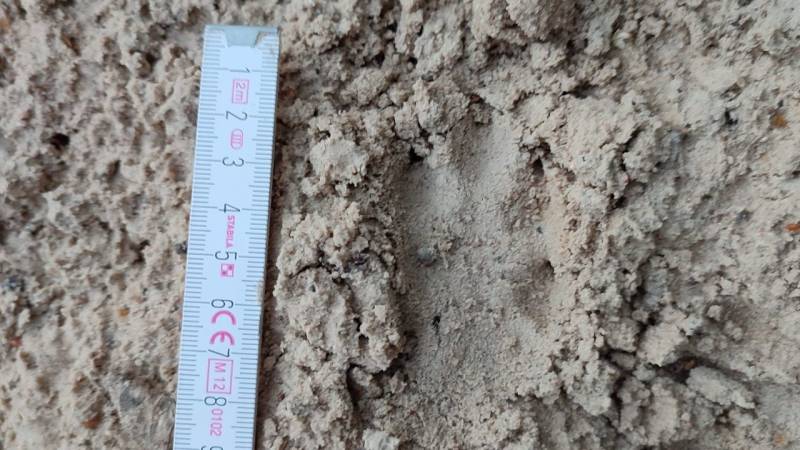
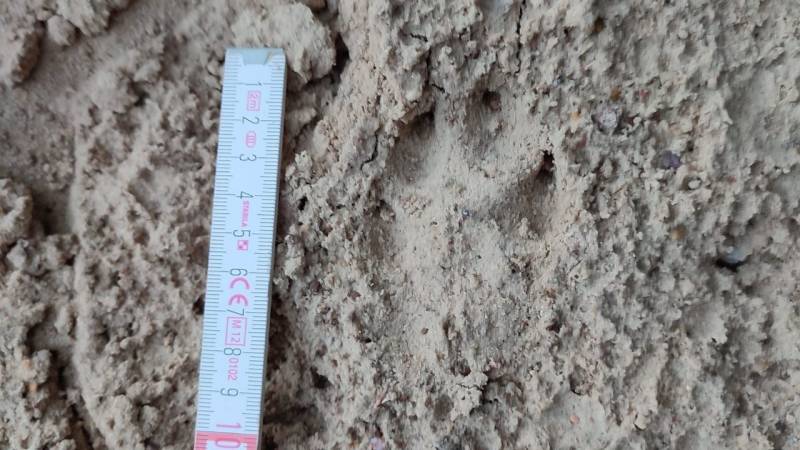
Here I have another video (in German) for you with tracks of the European hare in the snow:
Special Features and Risks of Confusion
Important: You can easily confuse rabbit tracks, especially the hind footprints, with those of foxes, dogs, and martens. But take a closer look. You can clearly recognize a rabbit by its gait - hopping.
Trackers call this gait parallel jump. First, the front feet come down (not next to each other, more one after the other) and then the larger hind feet follow and overtake the front feet.
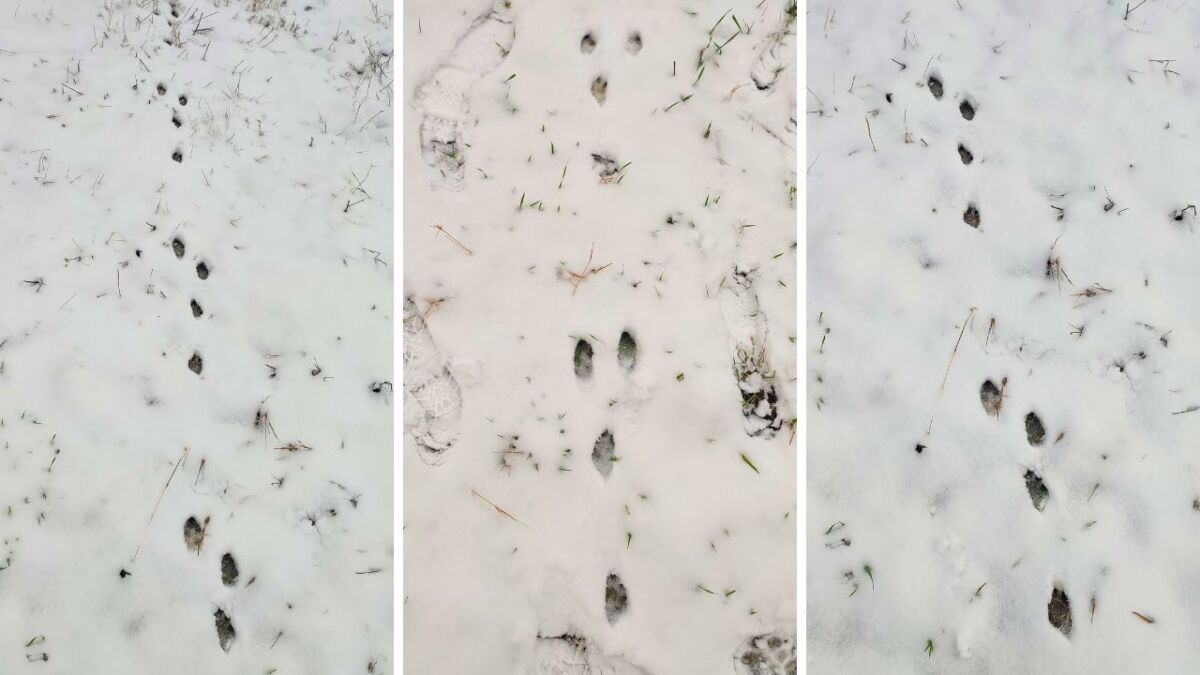
Every rabbit has its own story and leaves its own trace; learn to read them, and you will become part of its world." That's what always comes to mind when I see these little signs in the snow.
Now that you know that, grab a warm jacket and go outside - the tracks are waiting for you. And if you need additional information or are just curious, discover more in our animal track database for the hare. Happy Tracking!
Cat Tracks - A Very Special Impression
The silence of the forest surrounds you, your eyes scanning the ground. On the hunt for signs in the snow.
There! An imprint ... small, elegant, a cat was here. But what does this silent witness reveal to you about the secret hunter?
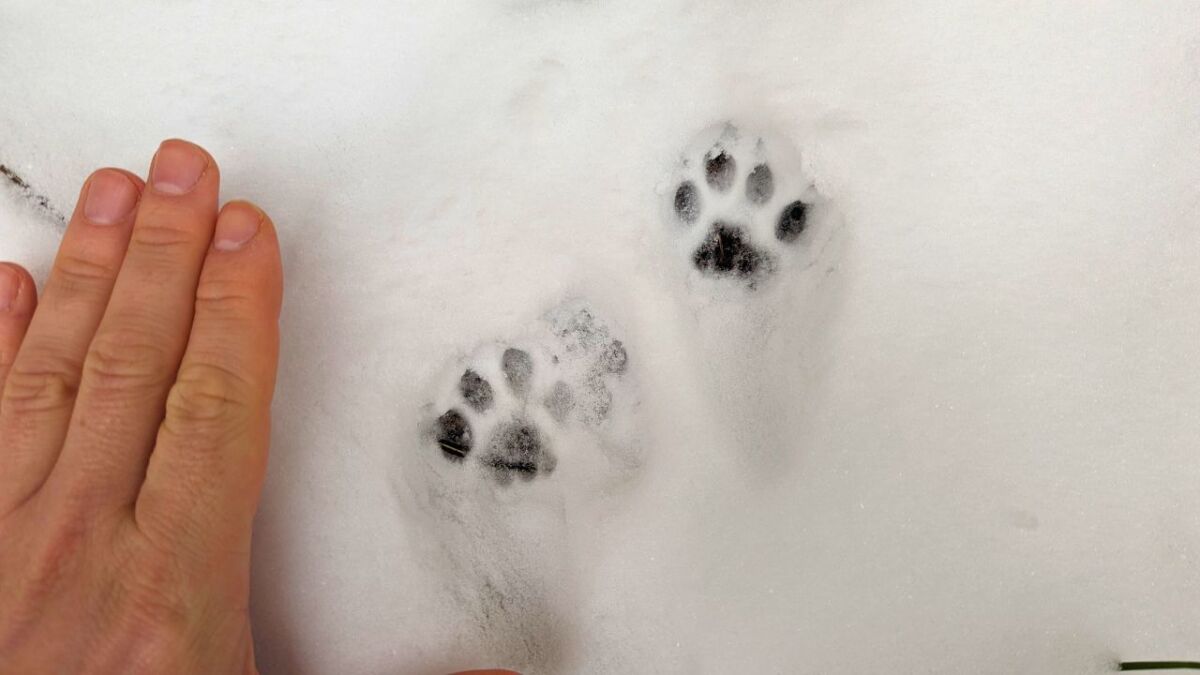
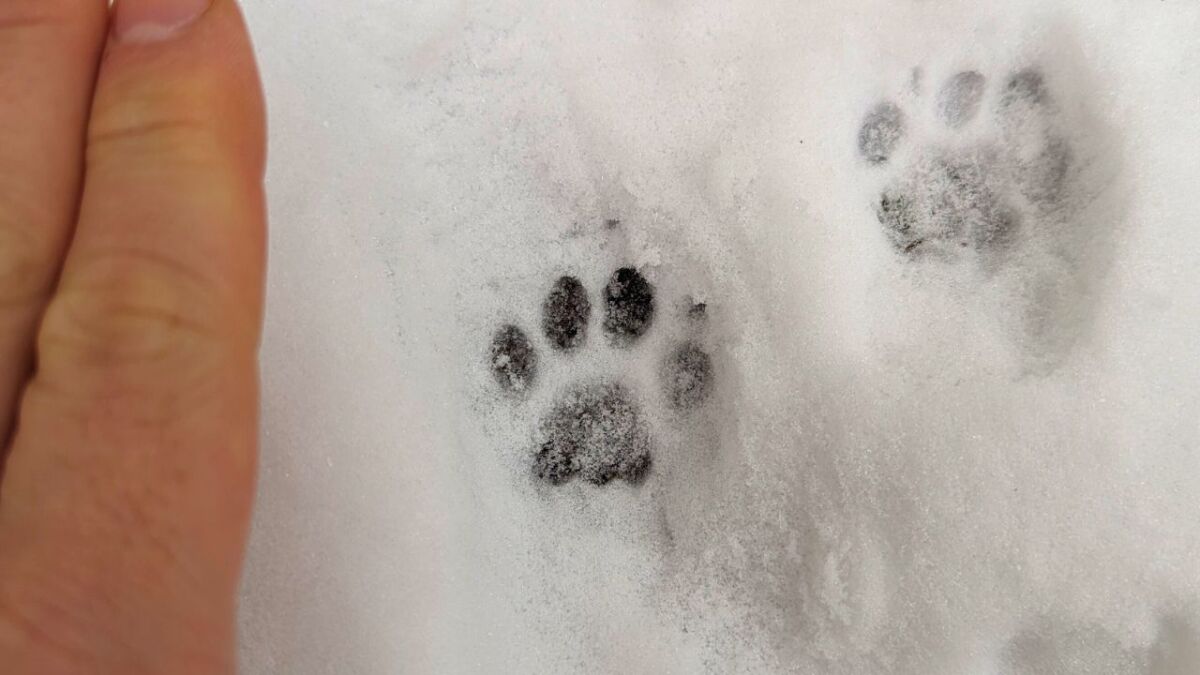
Features of a cat's paw
Every footprint in the snow is a fingerprint of the forest. Cat tracks are like a signature: unique, mysterious, fascinating. With these clues, you will become a master detective:
- Toes: Four on each paw, arranged in an almost perfect semicircle.
- Claws: Usually not visible - cats have retractable claws.
- Webbing or Hair: Cat paws do not have webbing. Sometimes they leave delicate traces of hair.
- Pawprint Shape: The prints are round to oval, with a characteristic large central pad.
- Symmetry: Cat prints are slightly asymmetrical.
- Size: A typical cat pawprint measures about 3 to 4 cm in length and width.
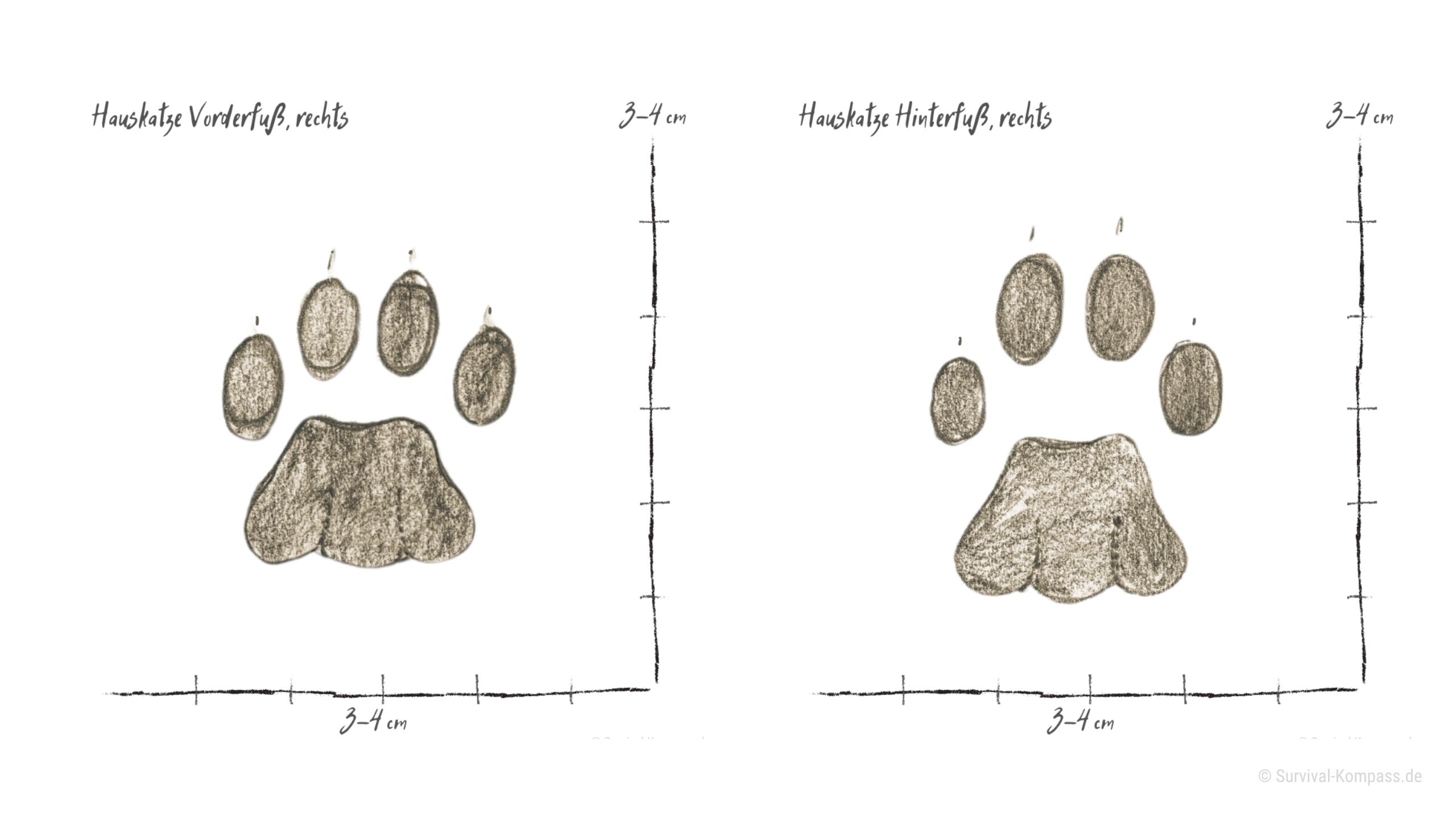
Special Features and Risks of Confusion
There are often these moments in the forest when the snow whispers secrets. For example, that you can distinguish a cat's paw print from that of a small dog by looking for the absence of claw marks. Cat paw prints are also softer and rounder in their overall shape.
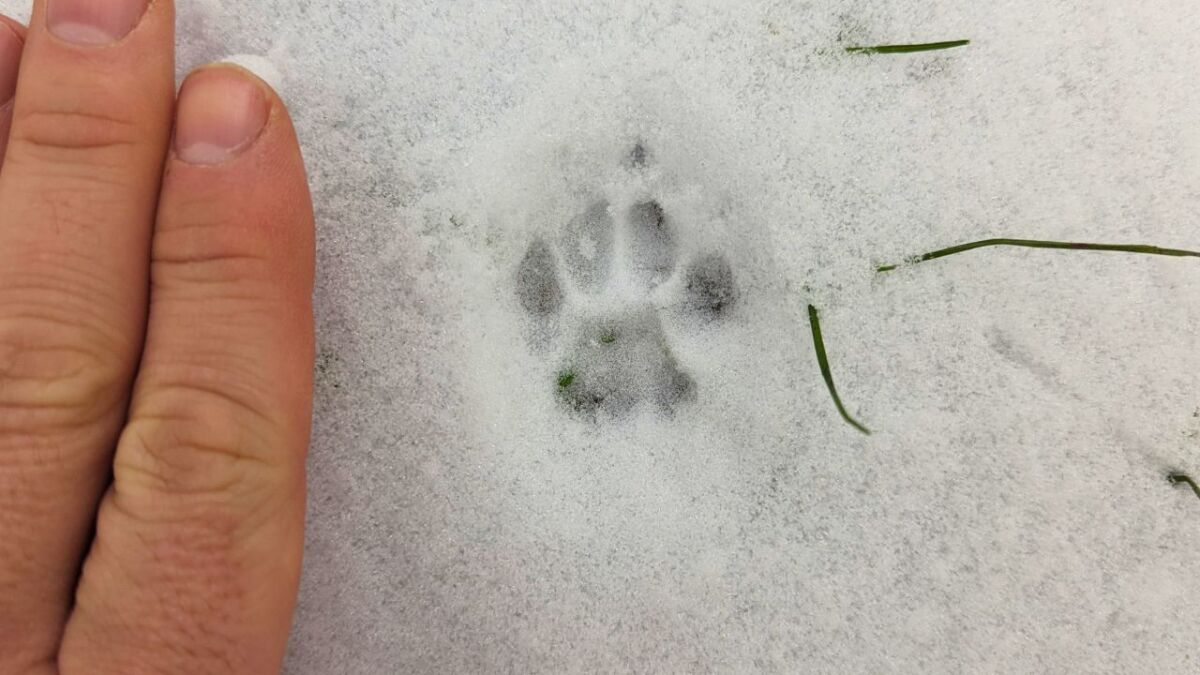
Pay attention to the following unique feature:
👉 The metatarsal pad has two bumps on top and three bumps on the bottom. When you see this sign, you can be sure that it is a feline animal.
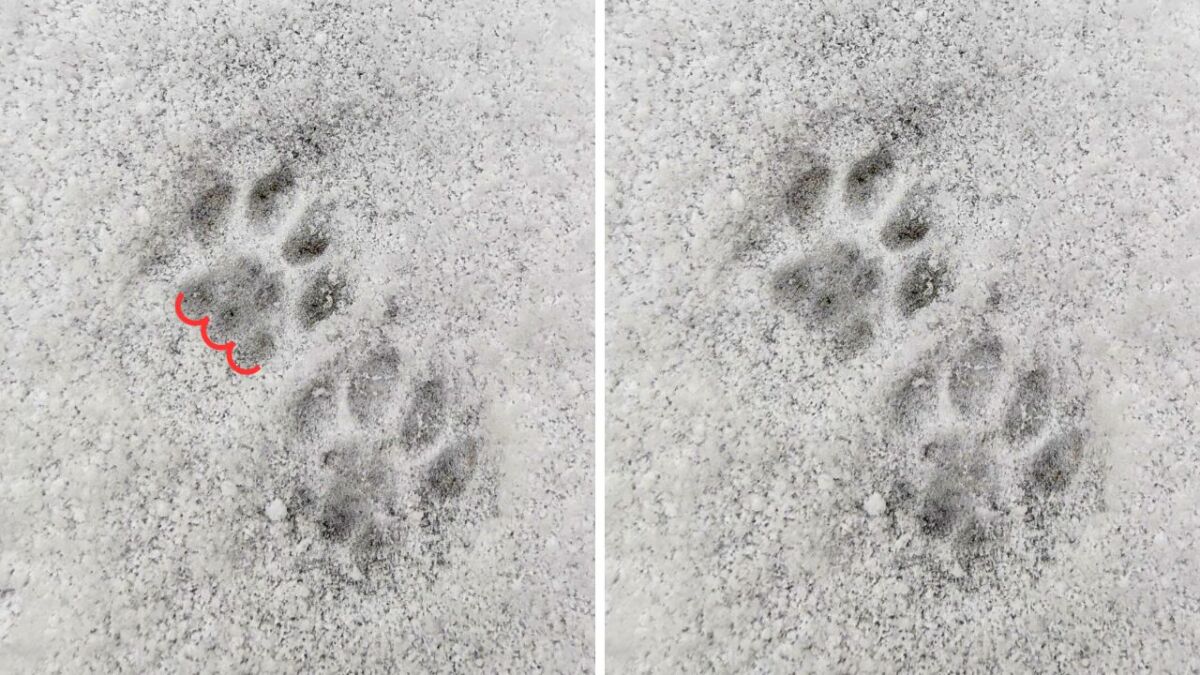
For you, I have here a video (in German) about the paw print of the cat.
Final Challenge
Take your time to study the shapes. Remember: Cats usually move cautiously, their steps are controlled because they are "ambush hunters".
It's time to go outside and test your newly acquired skills. Become part of the silence and discover the signs that cats leave in the snow.
Do you crave even more knowledge? Then sneak like a cat through my animal tracks database for cats and expand your understanding of these elegant creatures. Happy tracking!
Marten tracks - Interpreting animal tracks in the snow
The marten, a mysterious forest dweller, rarely seen, but betrayed by its tracks in the snow. You feel the cold on your skin as your eyes focus on searching the snow for these tracks. Found! Now, how do you read the message they leave behind?
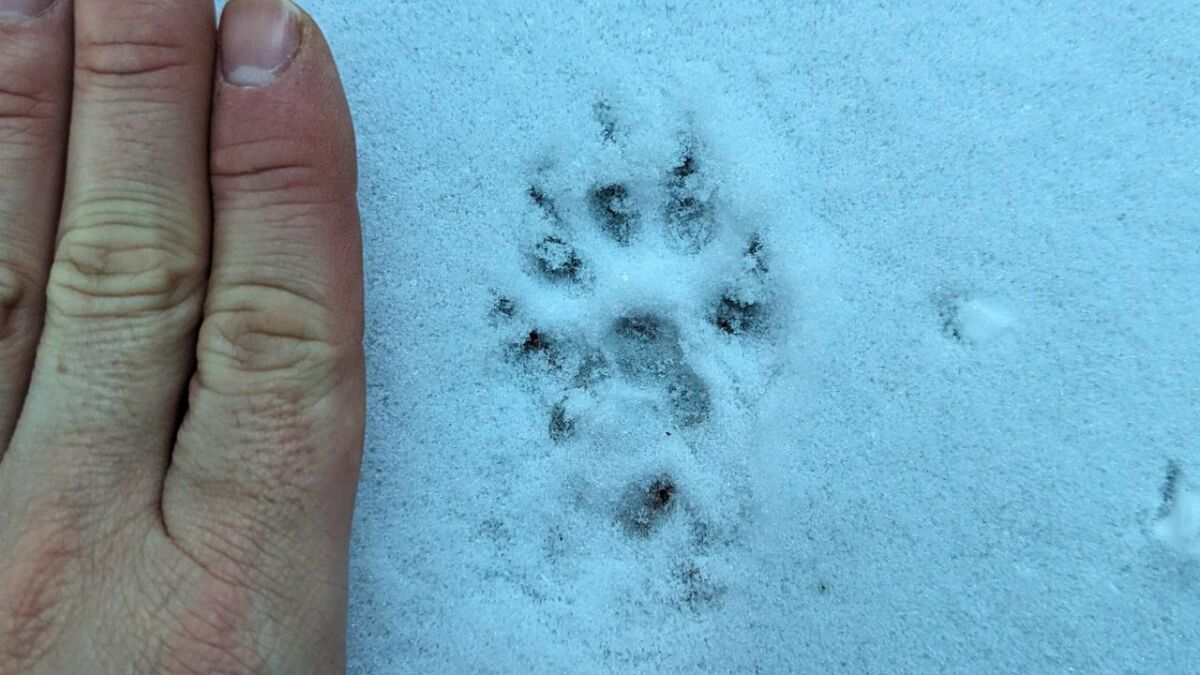
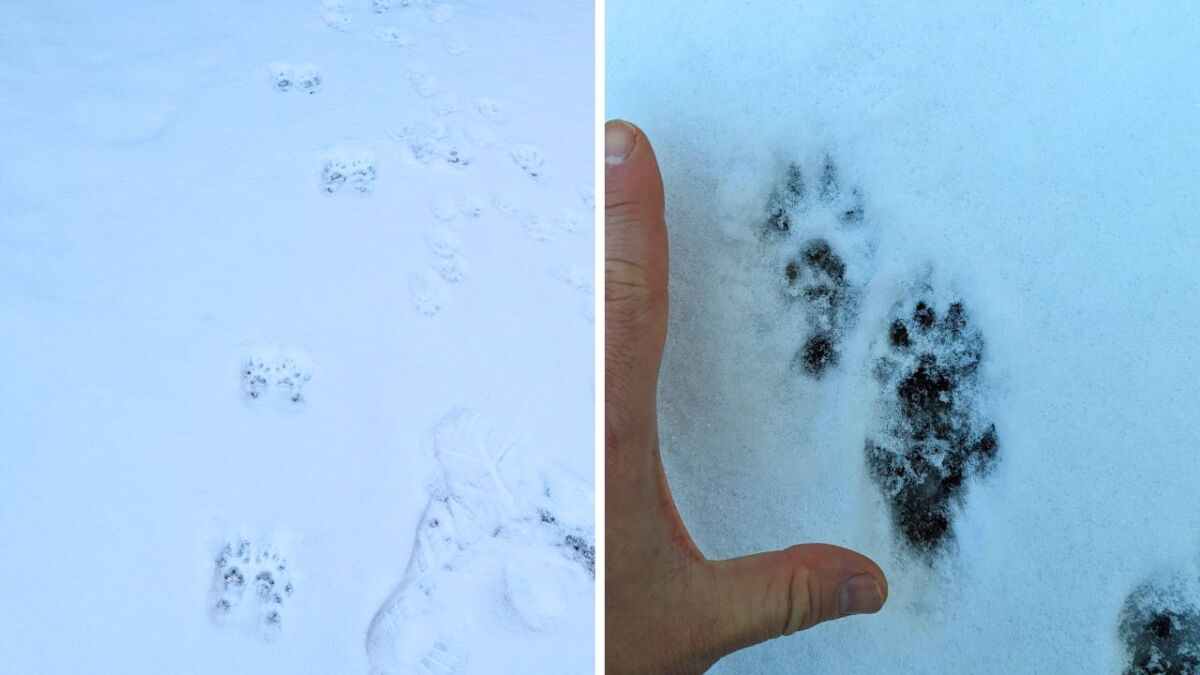
Specific characteristics of the marten
Marten tracks are like an encrypted code of the wilderness that needs to be deciphered. Here are your keys:
- Toes: Five on each paw, with visible claw marks. Often only four toes visible.
- Claws: Often visible, as martens cannot retract their claws.
- Webbing or hair: No webbing, but sometimes hair around the imprint.
- Track shape: Rounded to oval, often with a missing imprint of the fifth toe.
- Symmetry: Often asymmetrical, caused by the arrangement of the toes.
- Size: Proportionate to body size, large feet. The imprints are
- Front 4–6.4 cm long and 4.4-6 cm wide
- Back 4.2-6.3 cm long and 4.2-5.4 cm wide
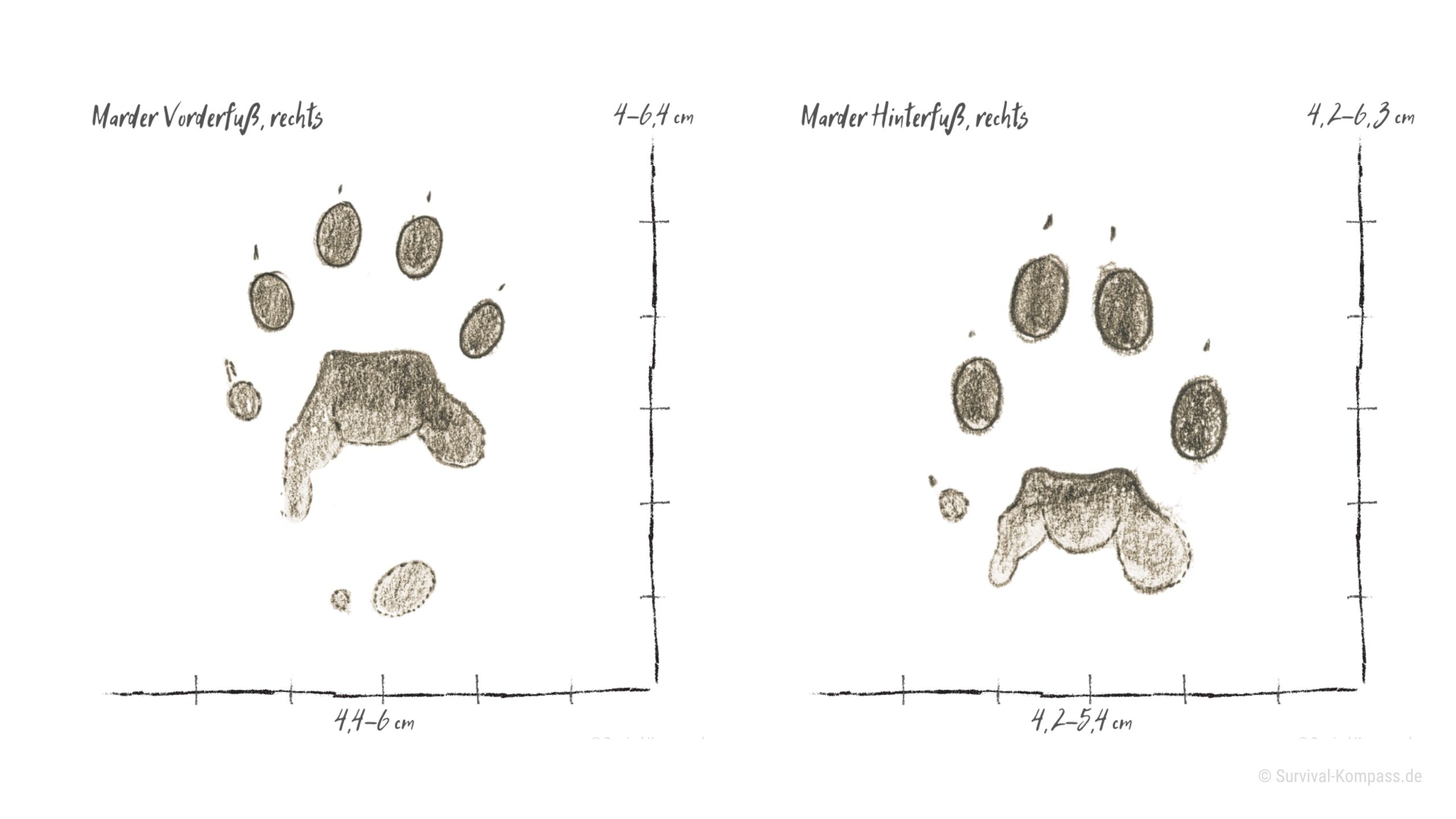
Special Features and Risks of Confusion
Marten tracks tell of nocturnal expeditions and daring leaps. They can easily be confused with cat tracks or those of young foxes, but marten tracks can often be differentiated by the fifth toe and slight asymmetry.
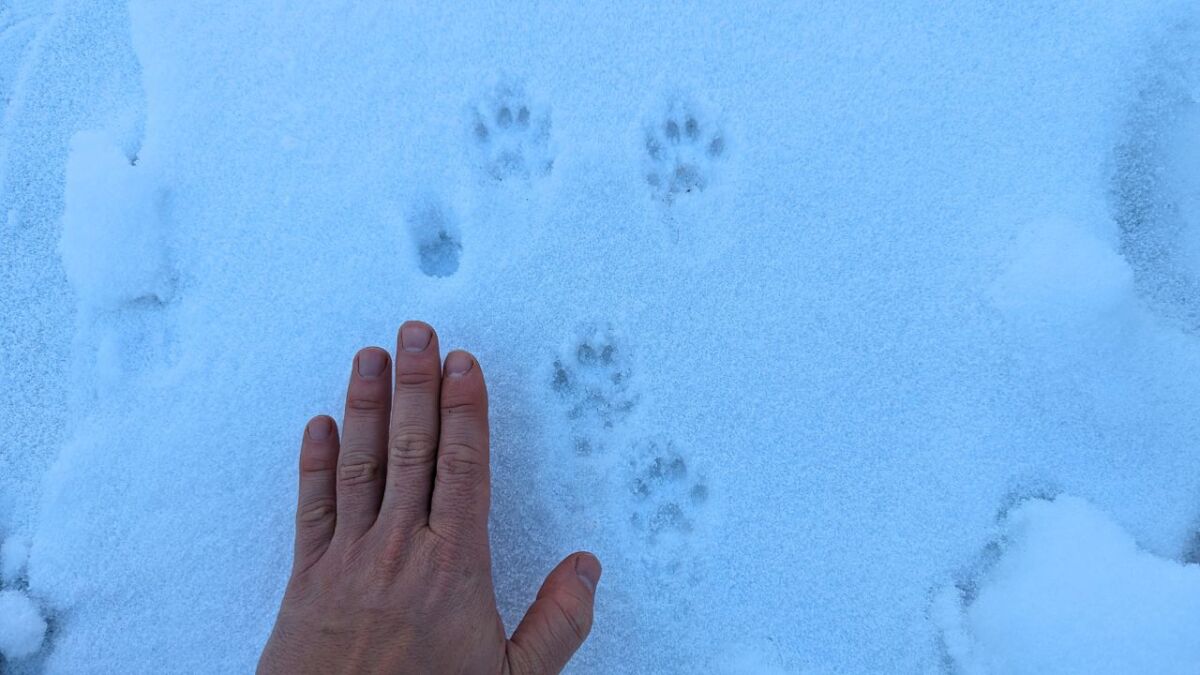
Cats usually have their claws retracted, while those of the marten are often visible. Sometimes, in the snow, one can mistake marten tracks for raccoon tracks, so it helps to look closely.
Here I have another video (in German) for you with marten tracks and their footprints as well as typical gait.
A marten leaves more than just tracks in the snow; it leaves stories of its wildness and freedom.
Final Tip
Follow the trail and pay attention to the pattern: Often you will see double tracks that are created by jumps, because martens move by hopping. This clearly distinguishes their tracks from those of a cat.
Take the freedom to follow in the footsteps of the marten. Get ready to immerse yourself deeply in the art of tracking and visit our animal tracks database for martens to deepen your knowledge. Have fun on the search for tracks!
Bdager Tracks - Interpreting the Footprints of the Animal Species
A cracking branch under your boots, fresh snow glistening in the moonlight. You are on a trail, a badger trail - a rare and exciting sign.
The badger, this host of the forest, is rather nocturnal and shy. But here, under the stars, it shares its nightly wanderings with you.
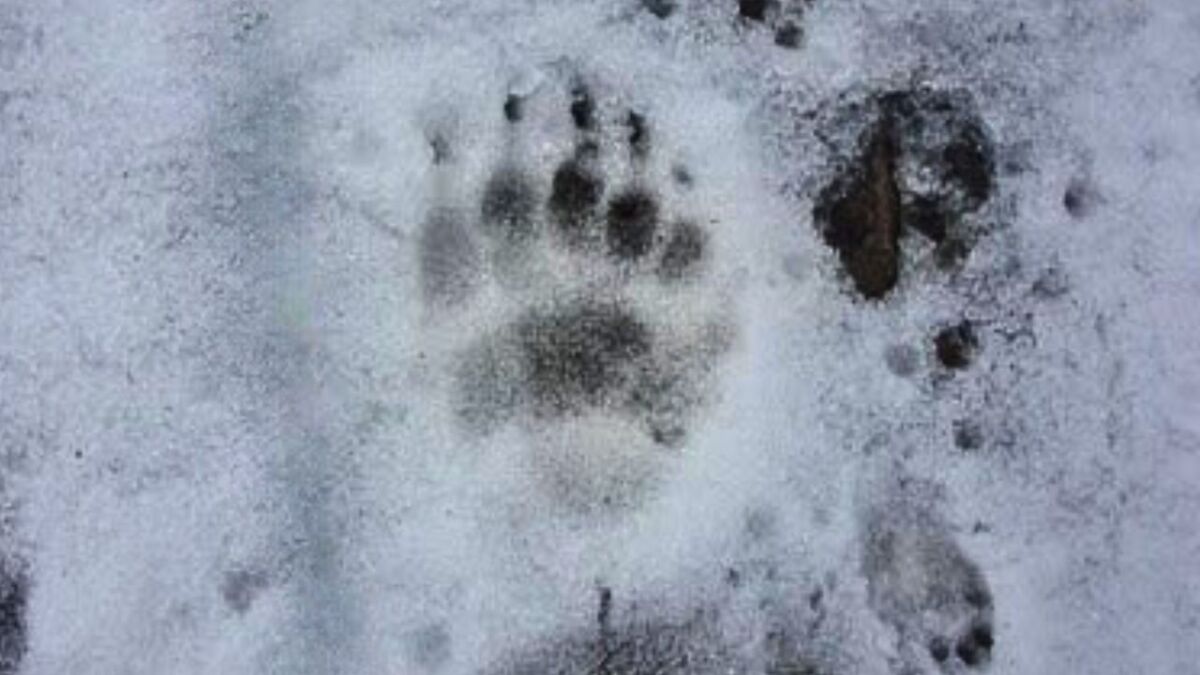
Characteristics of Badger Tracks
Reading animal tracks is like looking into an ancient book of forest secrets. Each page is an imprint, each imprint a word. Here are the details:
- Toes: Badgers leave five toe prints on their front and hind feet. The thumb is sometimes not visible in the track.
- Claws: Their claws are long, strong, and leave distinct marks in the snow. The claws have a greater distance from the toes in the front than in the back.
- Webbing or hair: Badger tracks rarely show hair, and they do not have webbing.
- Track shape: The footprints are often wider than they are long (excluding the claws), with an almost rectangular outline.
- Symmetry: The prints are asymmetrical due to the uneven arrangement of the toes.
- Size: Wide and robust.
- Front: 5.2-11.6 cm long and 4.4-7.1 cm wide
- Back: 4.5-9.1 cm long and 3.5-5.7 cm wide
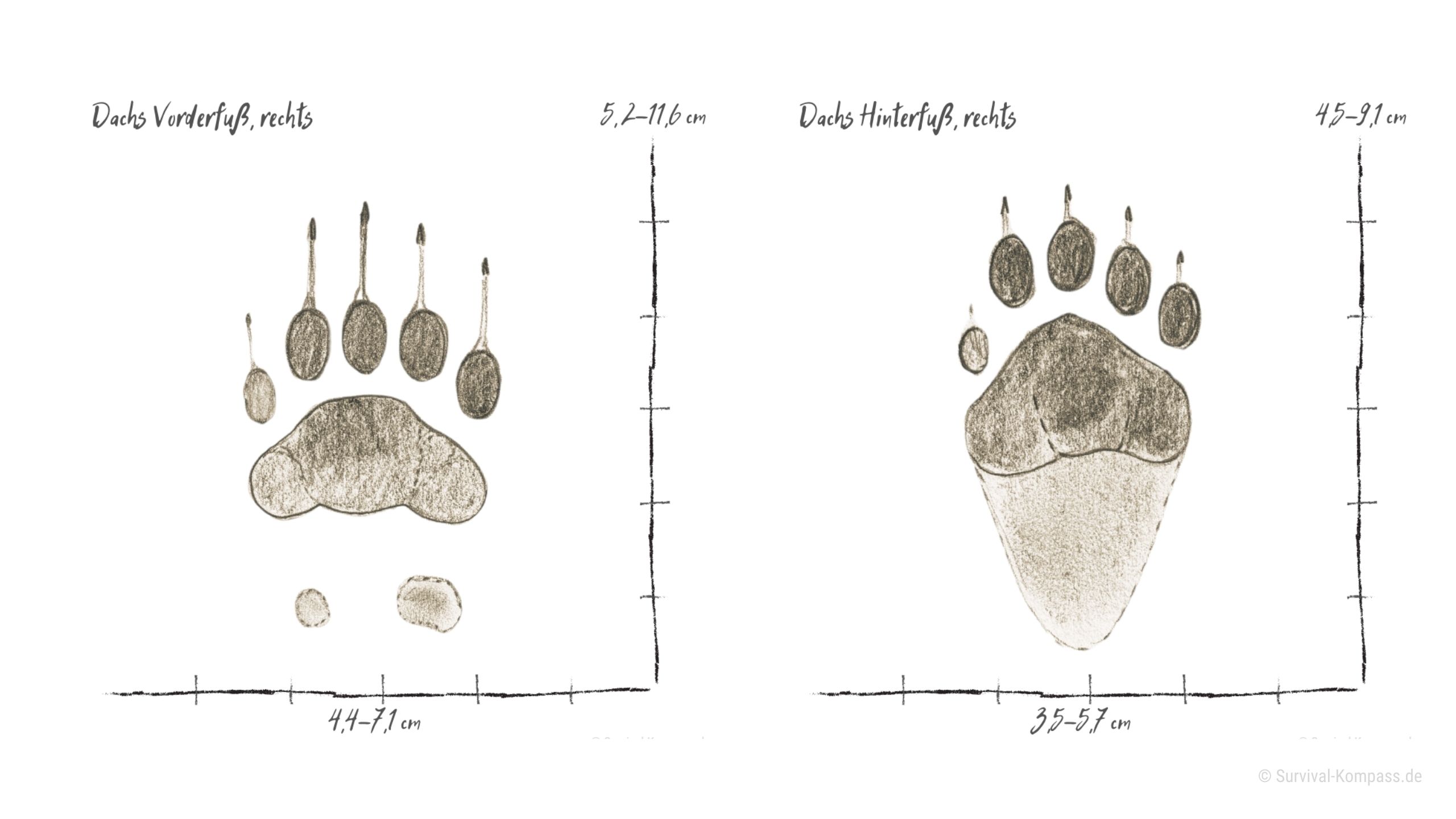
Special Features and Risks of Confusion
Badgers have an unmistakable charm, their tracks are unique - especially because of the long claws and the five toes. Badger tracks are almost unmistakable in their wide, almost sluggish presence.
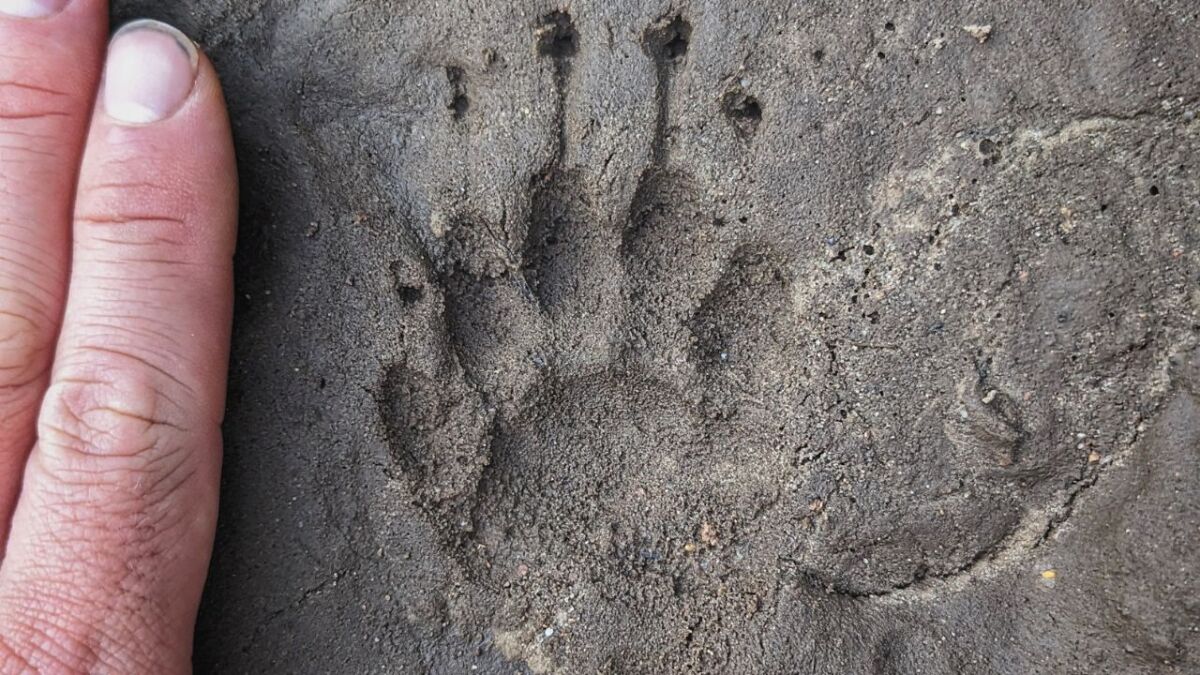
The forests are full of stories, and the badgers write their chapters anew every night. These stories await you, clearly written in the soft snow.
Final Tip
If you follow the path of the roof tracks in the snow, pay attention to how the footprints are mostly arranged on top of each other - a sign of the waddling gait of the badger. In tracking, this gait is called "foot-in-foot trot".
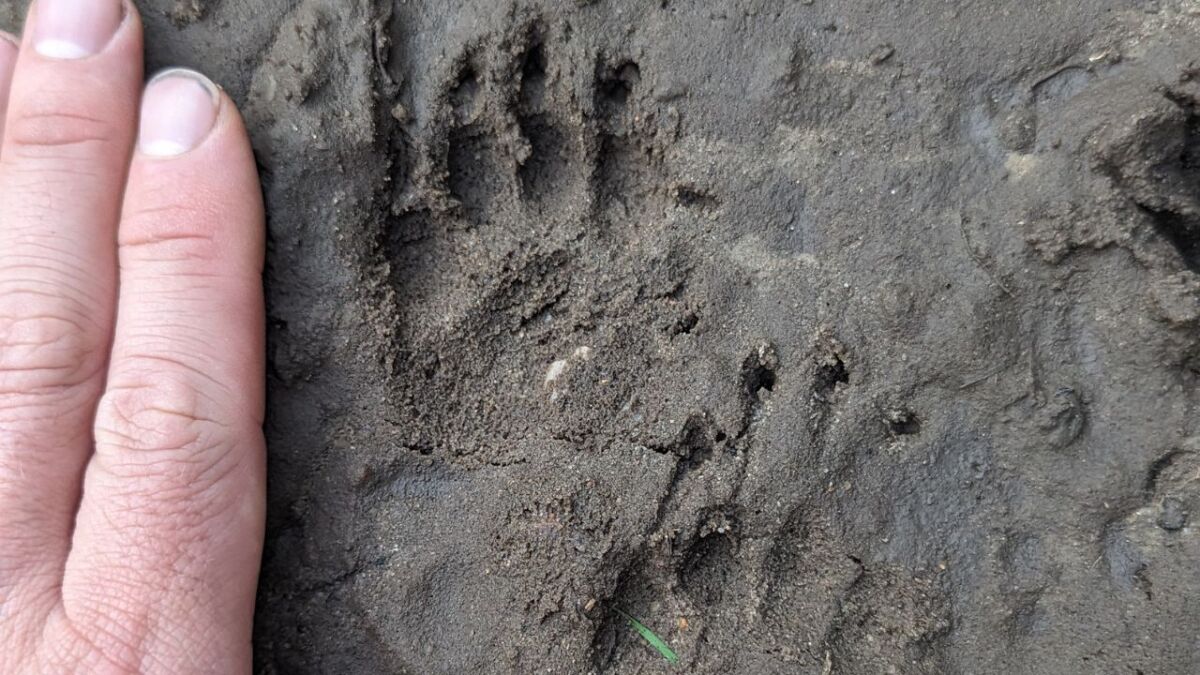
Now you are ready to write your own story in the snow. Go out, find the signs of the badger in the snow cover, and immerse yourself in the silence of the forest. More knowledge, more secrets? In my animal tracks database for the badger, answers are waiting for you.
Traces of raccoon in the snow
It's early in the morning, the first rays of sun are making their way through the treetops. You're on your way, on a path that tells stories.
Suddenly you see them - hand-like imprints in the snow. A raccoon was here, the little rascal has left its tracks.
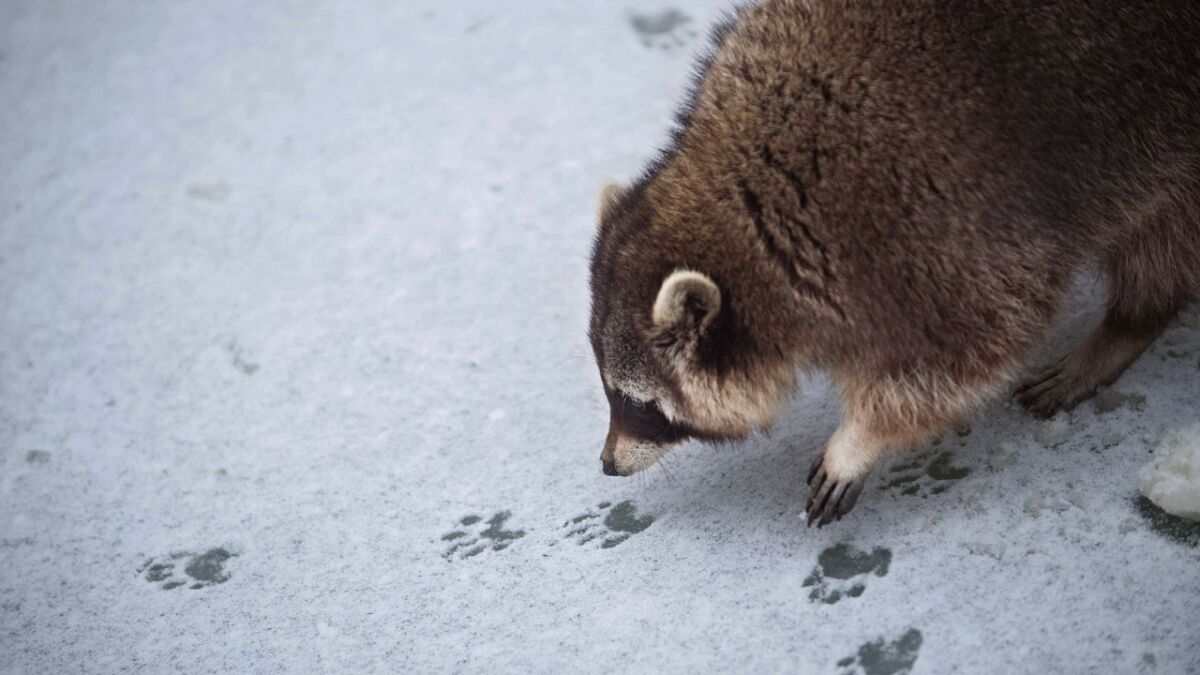
Hand-like imprints - like children's hands
Raccoons ... they are the mischievous little tricksters of the forest. Their tracks are like a fingerprint, unique and captivating. Take a closer look at these details and become a tracker yourself:
- Toes: Five, well spread out and with a recognizable hand shape.
- Claws: Yes, you can often see the small pointed claw marks that reveal the agility of their paws.
- Webbing or hair: No webbing, and no hair either.
- Track shape: The raccoon track is unique - almost like a small child's hand in the front, round in outline with spread toes.
- Symmetry: Almost perfectly symmetrical in the front, as if the raccoon knows how to place its prints artfully in the snow. Asymmetrical in the back.
- Size: Not very large, but clearly recognizable.
- Front: 4-8 cm long and 4-7 cm wide, more rounded
- Back: 4.7-9.8 cm long and 3.5-6.7 cm wide, more oval
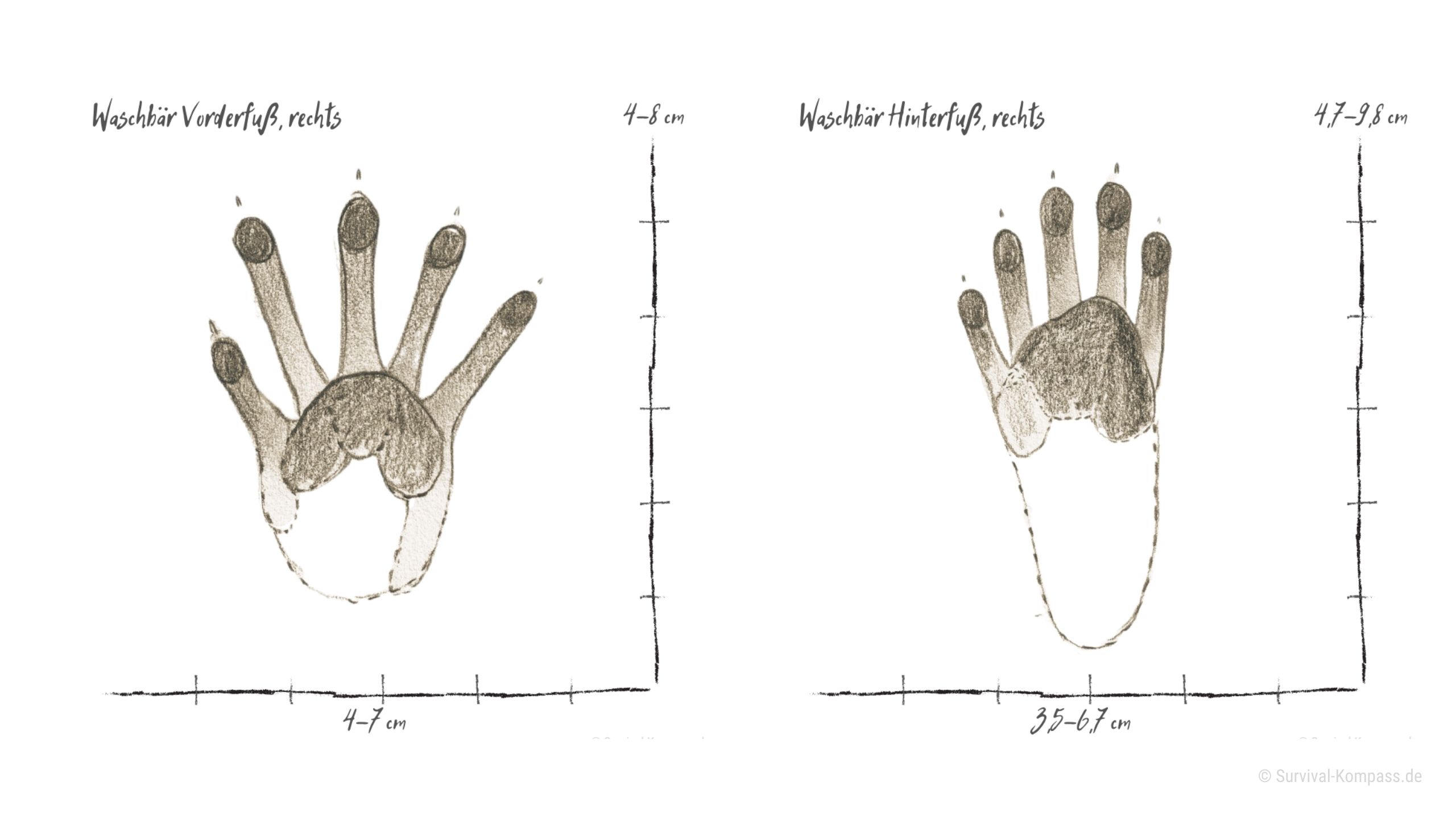
Special Features and Risks of Confusion
You could easily mistake the track of a raccoon for that of a small child - if it weren't for the claws. And where children play, the world laughs. Similar things could be said about raccoons, as they bring a playful curiosity to their explorations.
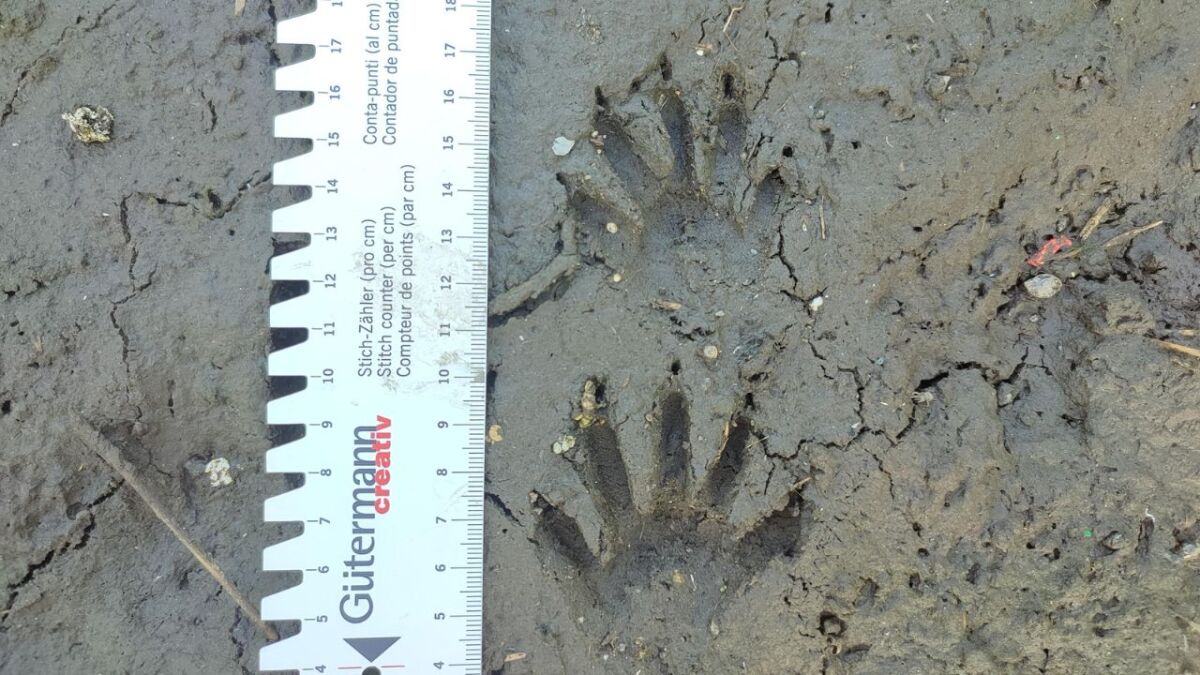
However, raccoon tracks can also be confused with tracks from the nutria - especially the front paw of the nutria plays a role here. In the snow, you can easily mistake a raccoon for other wild animals, including the otter.
In the imprint of a raccoon lies the joy of discovery, of play, of life.
These lines go through my mind when I find these small artistic traces.
Final Tip
Pay attention to the track pattern: Raccoons often move in a versatile gait. They walk foot-in-foot, diagonal walk, three- and four-jump, and sometimes move in parallel jump - it tells of their search for food and adventure.
You are now equipped to go out and discover the traces of raccoons. Take your time to gather deep impressions and immerse yourself in the rhythm of the forest.
And if you would like to learn more, then browse through my animal tracks database for the raccoon. Enjoy your search for tracks.
Interpreting dog tracks in the snow
Imagine: You are walking through a winter forest, the air is clear and cold. Your boots break the fresh snow. There, in front of you on the path, dance imprints in the loose white. Dog tracks - so familiar and yet full of secrets.

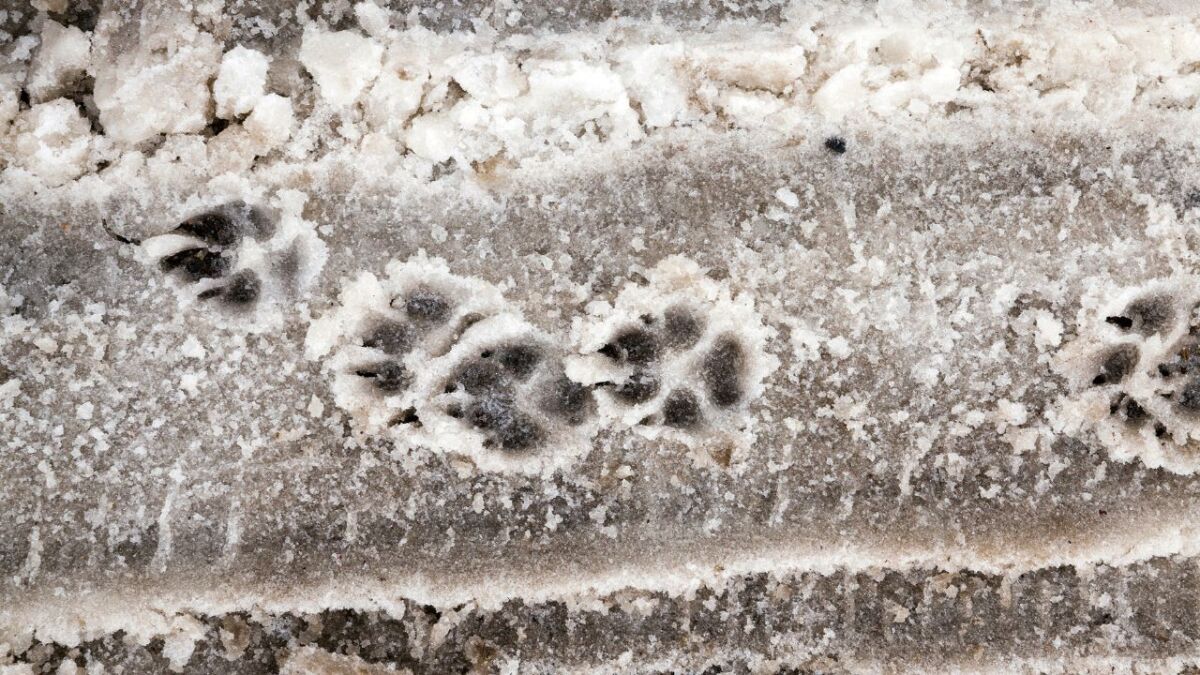
Distinctive Features
Deciphering dog tracks is like understanding a language known only to the snow and the forest. Allow me to explain the signs to you:
- Toes: Four are visible in the track, their arrangement vividly capturing the movement. However, there are 5 toes on the forefoot: Toe 1 on the forefoot is not visible, as it is higher up on the leg.
- Claws: Mostly visible, as dogs cannot retract their claws like cats.
- Webbing or Hair: Hair is rarely visible, webbing is not visible at all.
- Track shape: Often oval to round, depending on the breed of dog and the ground conditions.
- Symmetry: The tracks of dogs are symmetrical.
- Size: Varies greatly, from small terriers to large dogs, approximately 4 to 10 cm in length and 2.5 to 8 cm in width. Additionally, the forefeet are often larger and more robust than the hind feet.
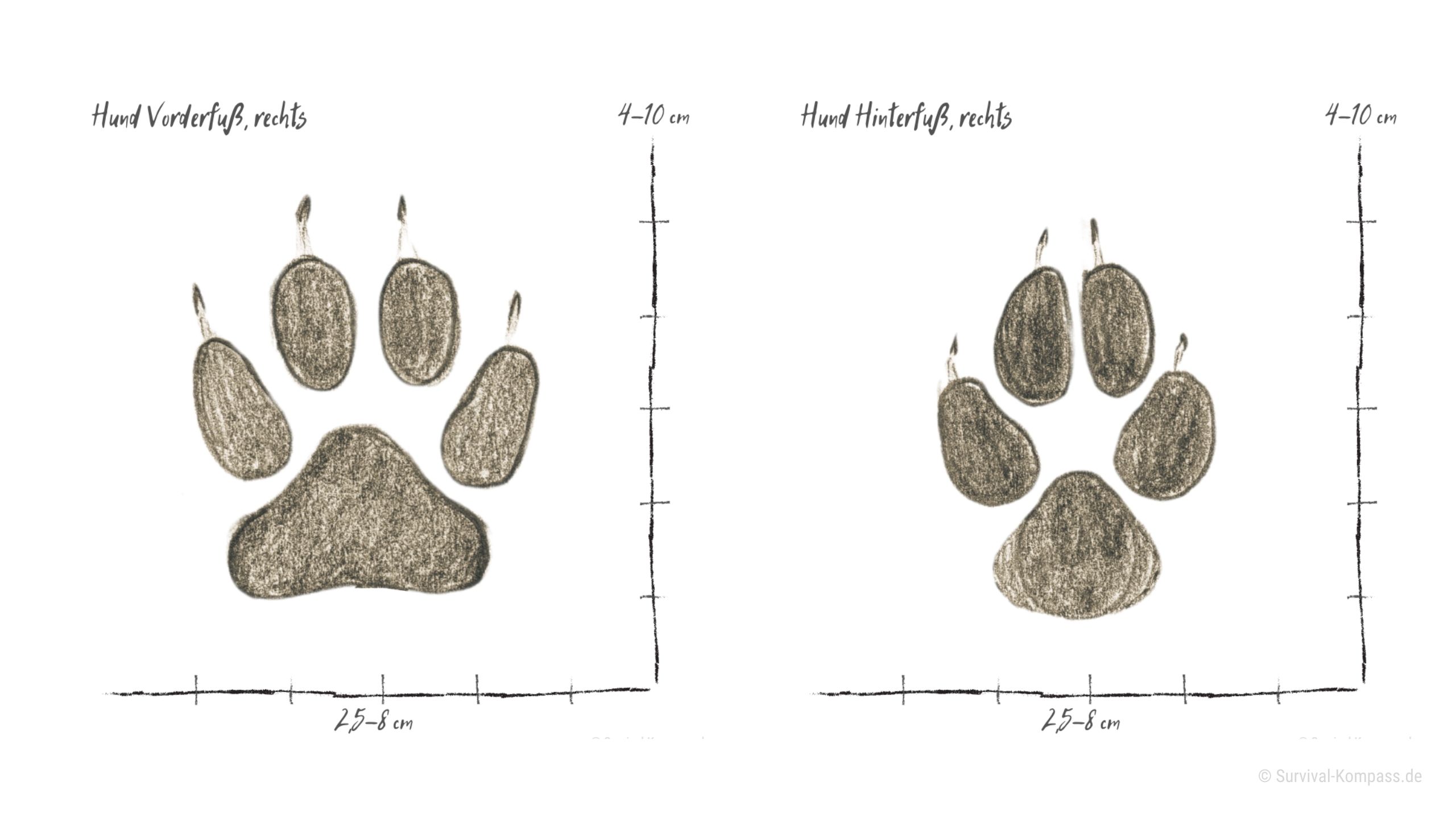
Special Features and Risks of Confusion
The dog tracks in the snow tell of playfulness and loyal friendship. But be careful, they can easily be mistaken for fox, cat or even wolf tracks. The difference lies in the subtle nuances of the track shape and claw imprints.
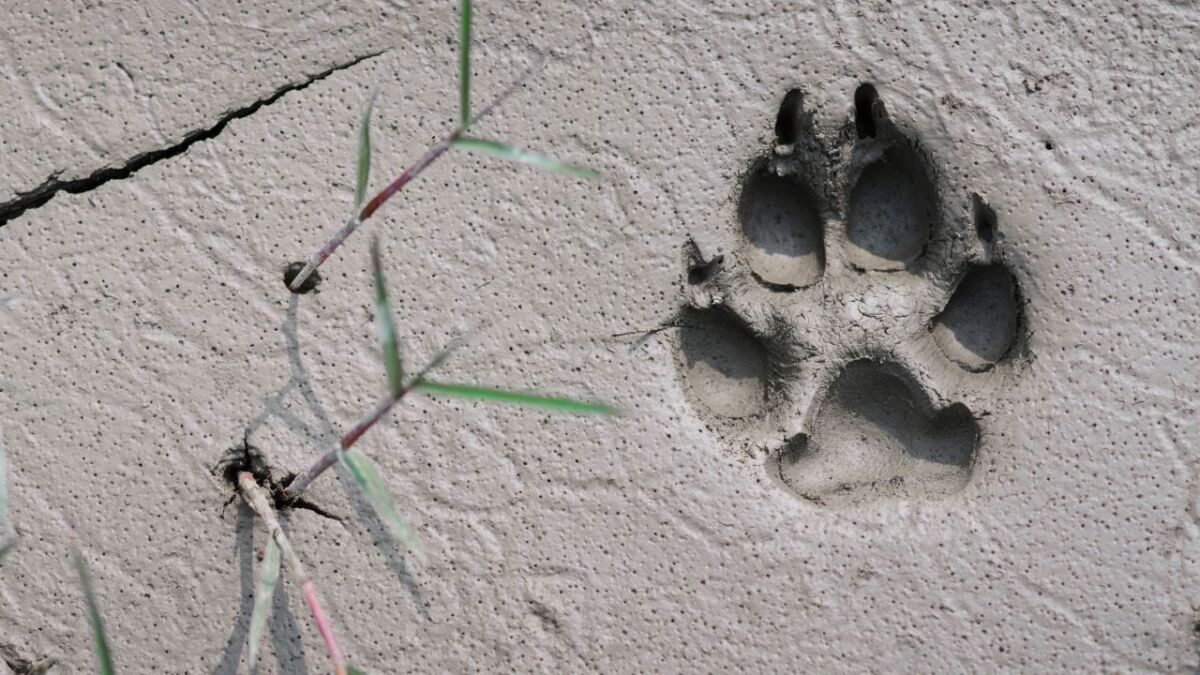
In addition, dogs have a lot of energy and do not need to conserve it in winter. You probably won't see a frolicking fox in the snow - it needs to save energy and chooses its targets and pace carefully.
In every dog's track lies an adventure, a story waiting to be told.
These conversations are held by dogs with the snow, and they invite us to listen.
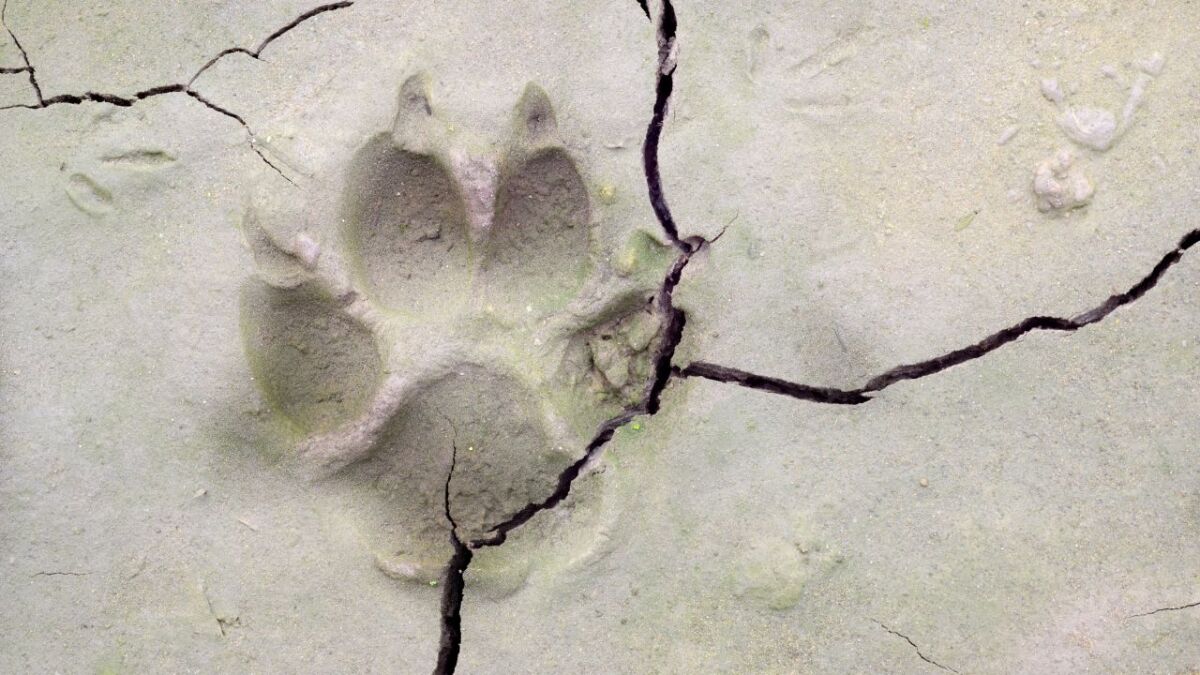
Final Tip
Pay attention to the pattern: Dogs often leave a so-called loping trot (like a fox), where the footprints are almost in a straight line, as the hind paws step into the imprints of the front paws.
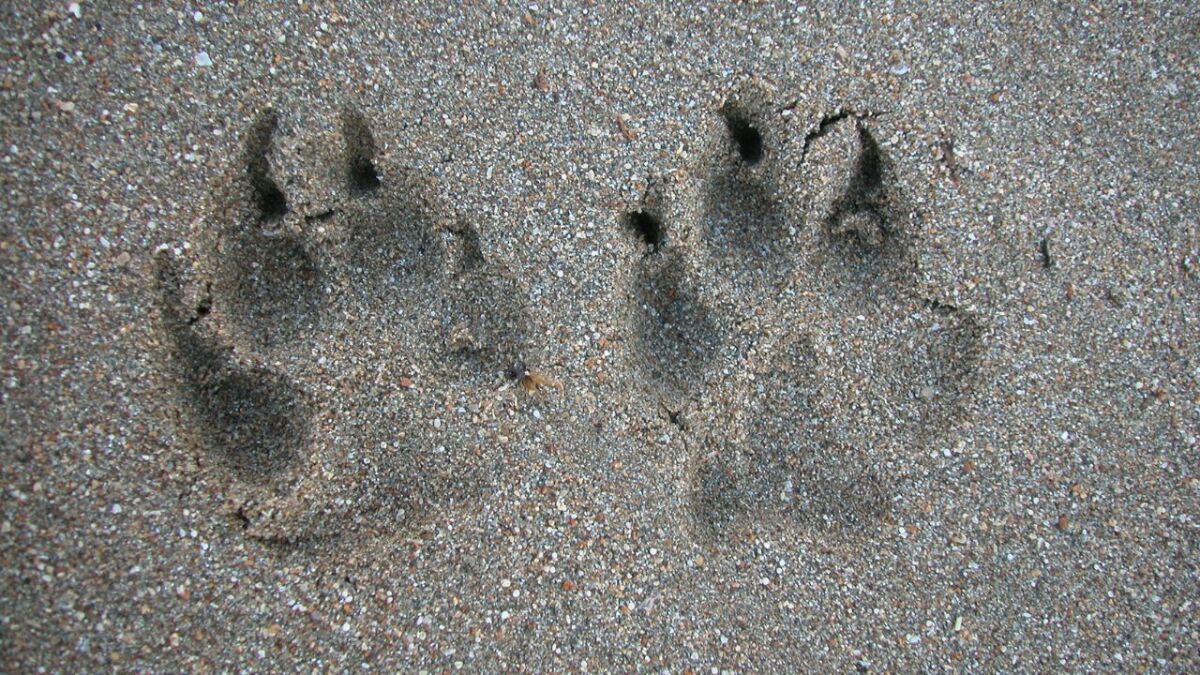
The world of dog tracks is open to you. Put on your boots and follow the call of the forest.
And if you have any questions or want to know more, visit my animal tracks database for dogs. Follow the trail and find your story!
Interpreting Traces of Carrion Crows and Corvids
You stand still, taking a icy breath, and look up at the treetops. The cawing of a crow breaks the silence.
Your gaze falls back on the snow, on the delicate imprints embedded there. Traces of a hooded crow - messengers between heaven and earth.
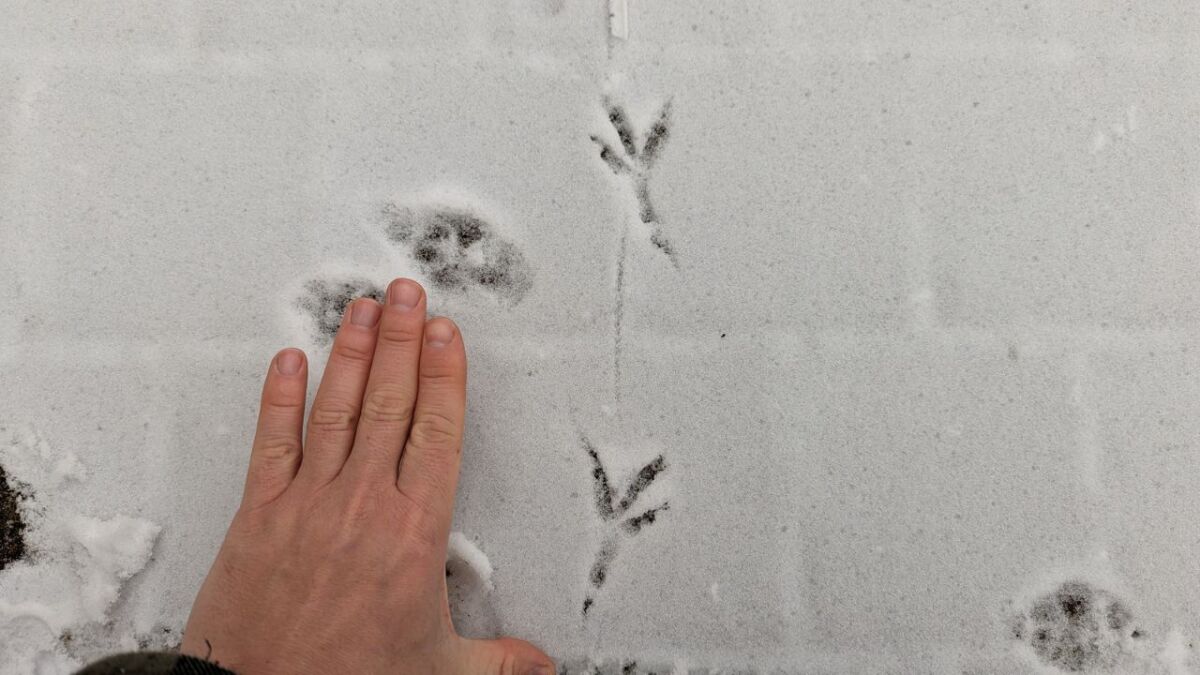
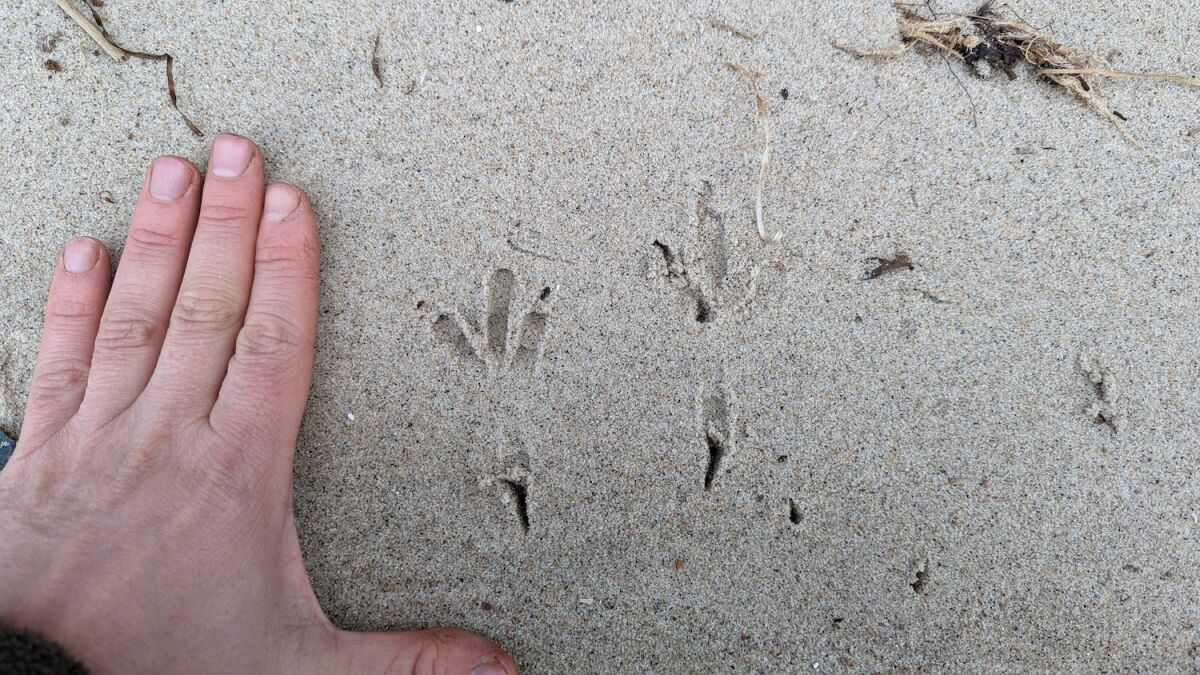
Distinctive Features
Finding crow tracks is like reading an ancient, venerable language - each feather, a letter; each claw, a word.
Here they are, the keys to translating the characteristic footprints of corvids:
- Toes: Four toes are clearly visible, three pointing forward, one pointing backward.
- Claws: Always present, a strong imprint of each individual claw.
- Webbed feet or hair: Irrelevant in crow tracks.
- Track shape: Jackdaw, carrion crow, hooded crow, or rook have a typical crow track.
- Symmetry: An almost symmetrical arrangement is present.
- Size: Small, yet distinctive, each toe measuring approximately 6.8-9 cm in length and 3-4 cm in width.
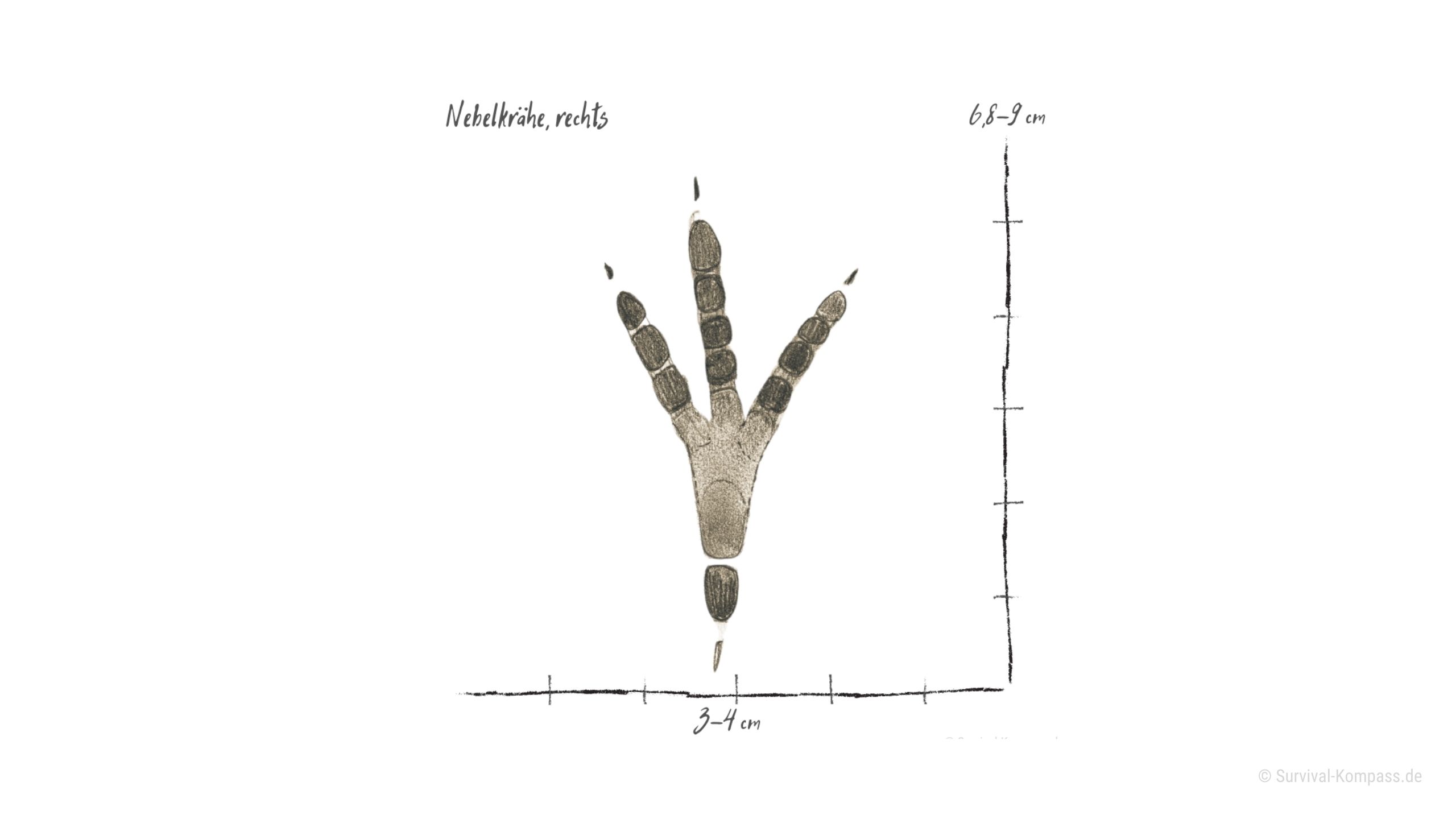
Special Features and Risks of Confusion
The track of the hooded crow can be confused with other birds of the corvid family, such as the magpie, Eurasian jay, or common raven (much longer and wider).
All corvids possess a remarkable feature that sets them apart from other birds:
👉 The inner toe is closer to the middle toe than the outer toes.
Here in the picture you can see what I mean. In English, tracking is also called "hugging toe".
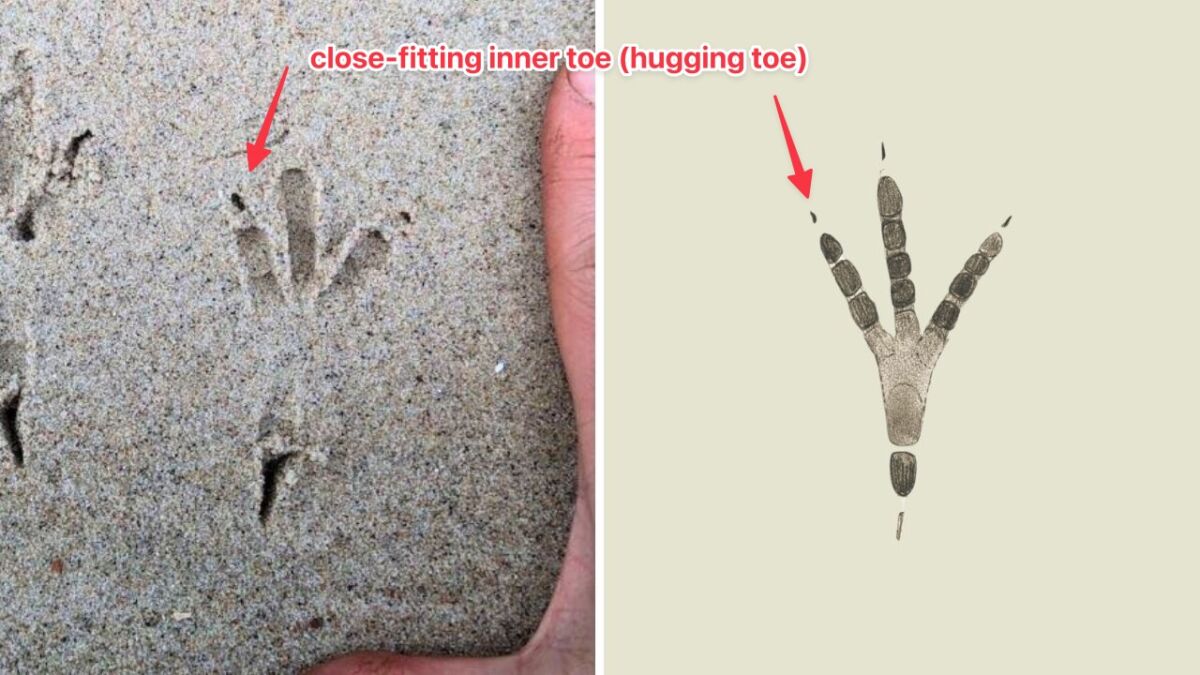
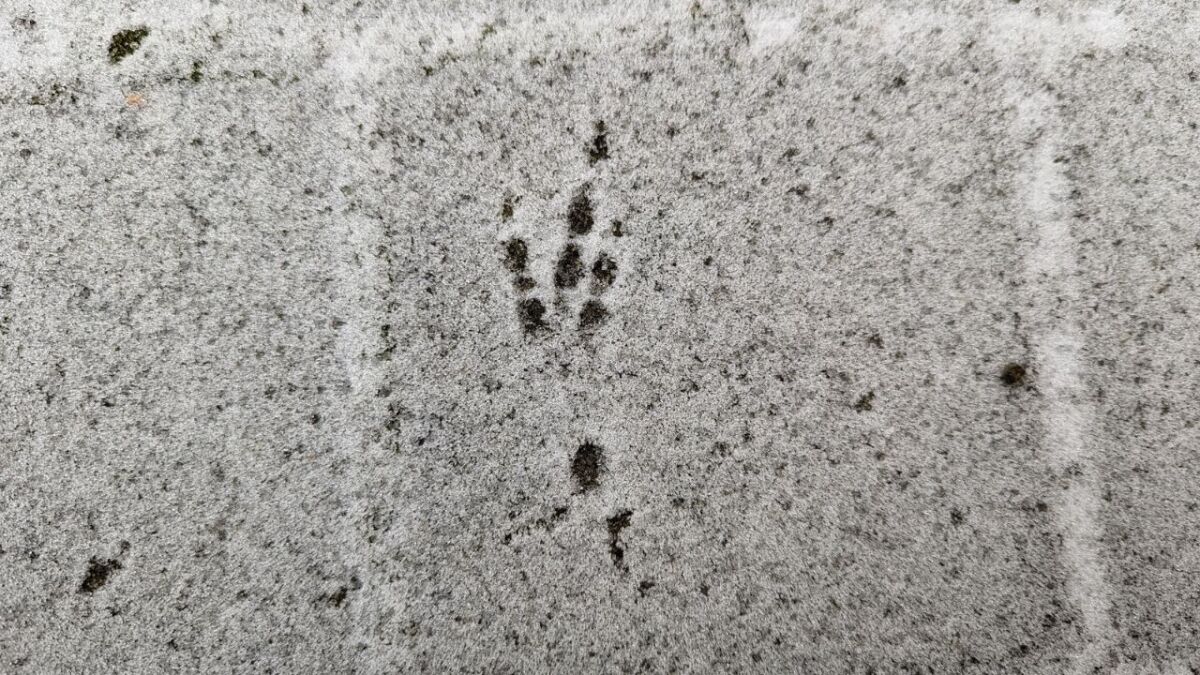
Every trace tells the story of life's journey, and the crows write their tales in the sky.
They also paint with their feet on the snow - small masterpieces of nature.
Final Tip
Look at the gait and the embracing toe: then you can already be sure that it is a corvid bird.
Now go out, find the tracks of the hooded crow and feel the poetry of winter. And if you want to deepen your knowledge, then fly into our animal tracks database for the hooded crow. Observe, learn, and understand the stories they leave behind.
Techniques and Tips for Beginners
Reading tracks is like solving a puzzle. Each track tells a story, and it's your job to decipher it. Here are some tips to get you started:
- Start with the basics: Learn the shapes of the most common animal tracks. Each track from every animal is unique, like a fingerprint.
- Use tools: A field guide or identification app can be very helpful in the beginning.
- Observe the gait: Animals move differently - some hop, others waddle or creep. The movement reveals a lot about the animal.
- Pay attention to distance and direction: The length between the tracks and their direction give you clues about the size and speed of the animal.
- Consider the context: Surroundings and vegetation can provide additional information about the animal in front of you.
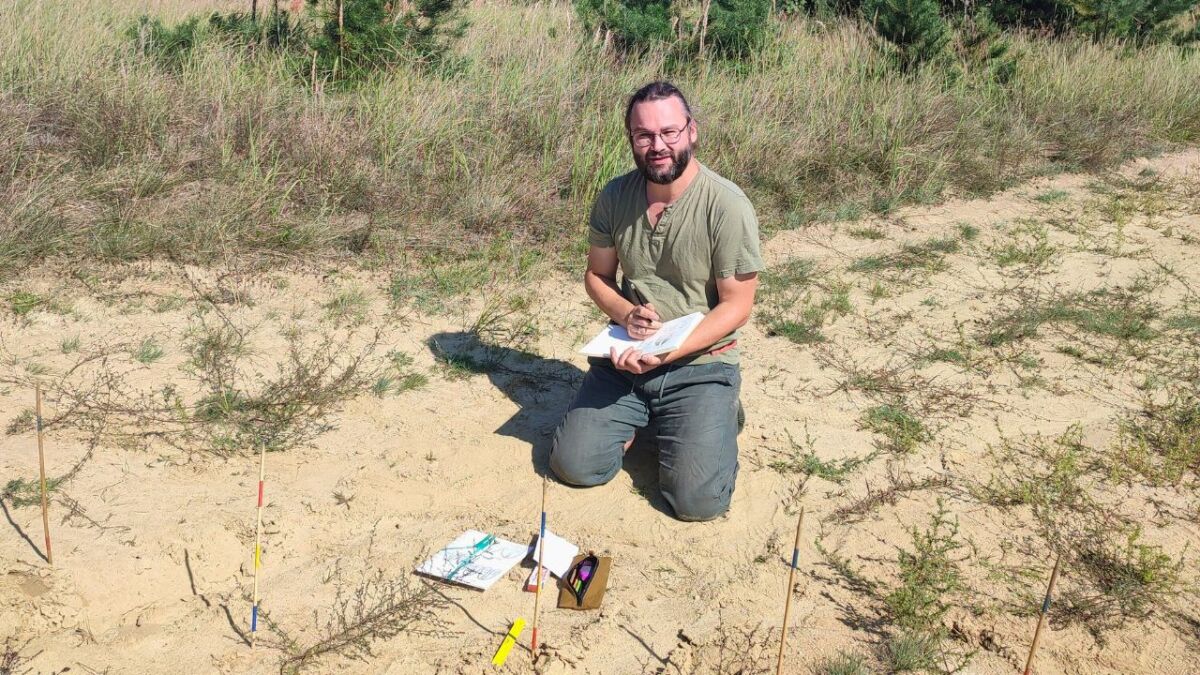
Application of Track Knowledge in Practice
Now it's time to practice! Every time you're outside, take the time to study the ground. With every track you read, you'll get better, more precise, and more connected to the world around you.
It gets particularly interesting in winter. The snow becomes a canvas on which the animals paint their tracks.
Snowshoes can be useful in this case, as they allow you to go further into the forest without leaving deep tracks.
The secrets of nature are laid bare - we just have to learn how to read them.
And you will succeed, step by step, track by track.
The art of tracking opens up a new world for you, a world full of stories and wonders. It enriches every hike, every adventure, and connects you more deeply with nature.
Examples and exercises for outdoor enthusiasts
You take a deep breath. The cool, clear air fills your lungs. In front of you lies the forest, covered in a white blanket of snow. Perfect for some tracking exercises, isn't it? This way, you not only connect with nature, but also sharpen your senses.
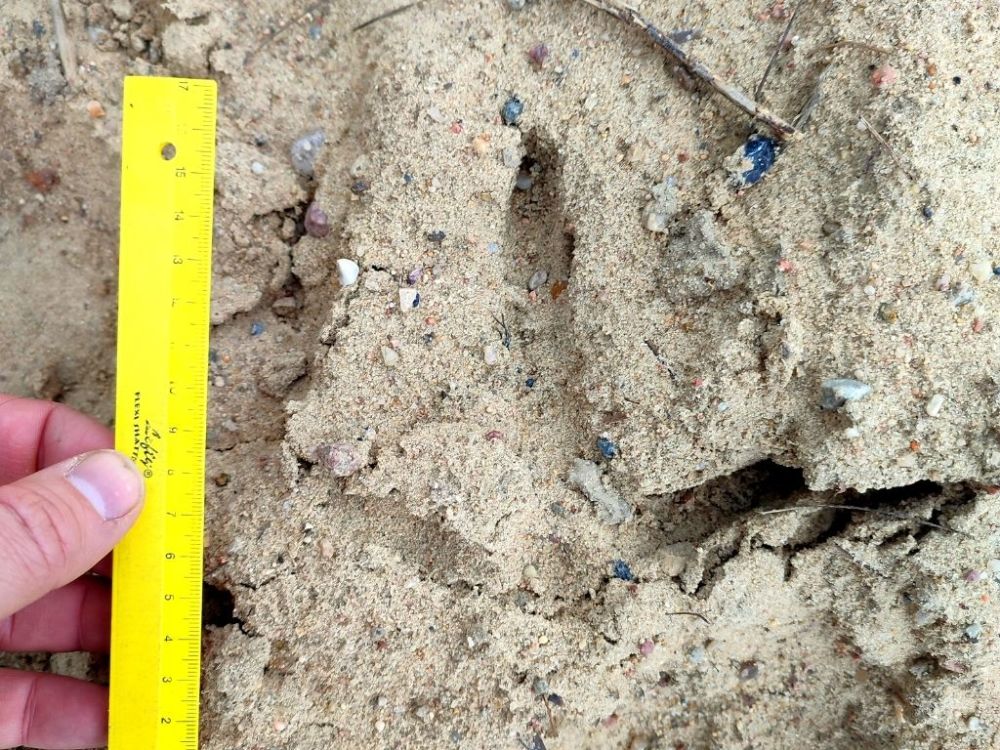
Tracking as a Connection to Nature
Since ancient times, people have been reading tracks. It is a deep, almost forgotten instinct. And with a little practice, it awakens again.
Here are my recommendations:
- Create a tracking diary: Document every track you find. Sketch, take notes on size and shape, and where and when you found them. What was the weather like? Where was the wind coming from? Where are the cardinal directions?
- Go tracking regularly: Practice makes perfect. Take every opportunity to be outside. Each season has its own signs.
- Practice with friends: Two pairs of eyes see more than one. Go out together, share observations, and learn from each other. Maybe you'll find someone in the companion search.
- Set yourself challenges: During a walk, set a goal to find a certain number of different tracks.
- Use technology wisely: Apps and online resources complement your outdoor experiences. But real learning happens outside, not on the screen.
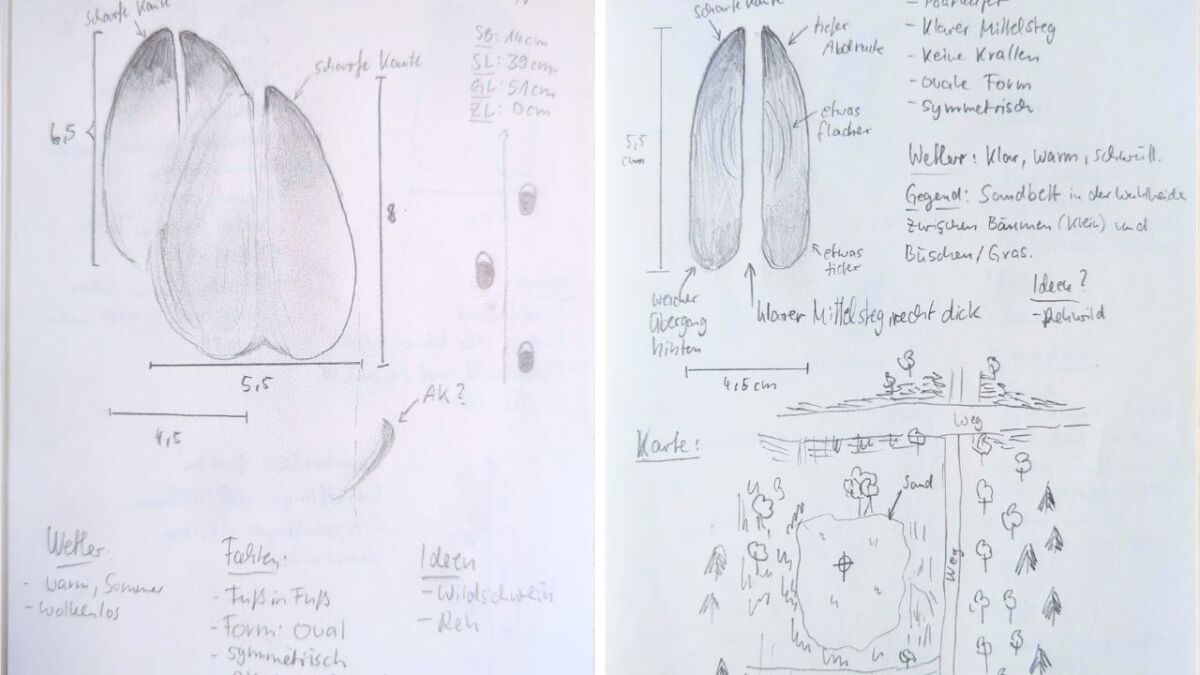
The Forest as a Teacher
Take the time today to find and identify a new trail. Perhaps that of a squirrel or the fresh tracks of a deer. Ask yourself: "What are these animals doing here? Where are they going? What do their tracks tell us about their lives?"
Every step in nature leads us to a deeper understanding of ourselves.
And that's exactly how it feels when you, side by side with the animals of the forest, leave your own tracks in the snow.
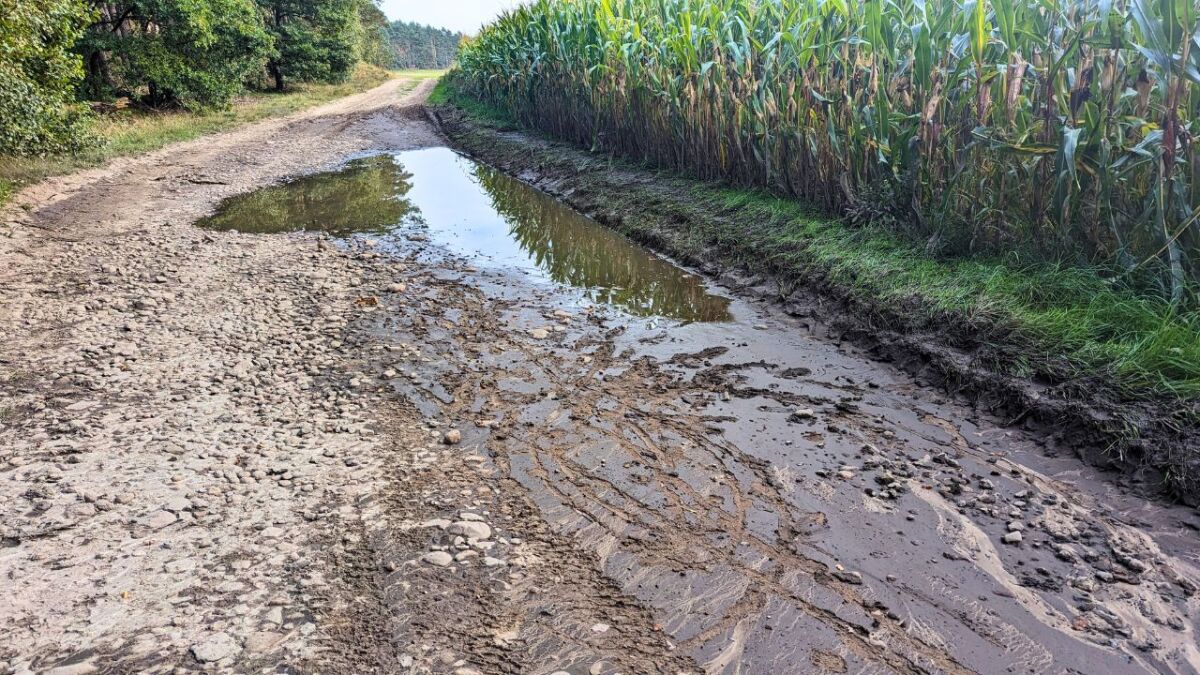
Tracking is not just a skill, it is a way of life. It is the careful observation and silent learning from the stories that the earth tells us.
Ready for your next adventure? Then lace up your boots and go outside. The forest is already waiting for you.
Take a closer look! - there is a lot of misinformation on the web
Unfortunately, there are countless websites on the internet that depict poorly drawn footprints. The proportions are incorrect, toes are completely misrepresented, and the spacing is completely off. It is sad that such fascinating knowledge is being spread incorrectly.
It seems as if the editors and authors never have taken photos themselves, apparently have never been out in the field, or use drawn images from photo databases (where the image creators themselves were probably never skilled at tracking).
I strongly recommend getting your information about animal tracks from trackers who have real practical experience.
👉 Use the website here or find a wilderness school with a tracking course.
Because if you learn from the ignorant, you will not enjoy tracking. The reason: Insufficient information leads to frustration, lack of success, and I even consider it a little dangerous.
What triggers misinformation? Instead of a delicate deer, a 400 kg boar then ran through your garden.
Note: I would never claim to be an expert in tracking and I would rather not be called that either. There is simply too much to discover and even we trackers can be wrong at times. I value my experience highly, with completed tracker training and several years in the field.
The Essence of Tracking
You have learned that every footprint, every claw, every tiny imprint in the snow carries a meaning.
You now know that the tracks are more than just markings. They are the echo of the forest - stories waiting to be heard.
Let's summarize what you have learned:
- Each track has its shape, size, and peculiarities. You have learned the differences.
- You have seen that the details matter: claws, toes, hair - they all reveal who has passed by here.
- You know that an animal's gait says almost as much as the track itself. Whether it's a trot, gallop, or hop - each gait has its pattern.
- You have understood that the environment is part of the story. The forest, the field, the river - they all influence the tracks you find.
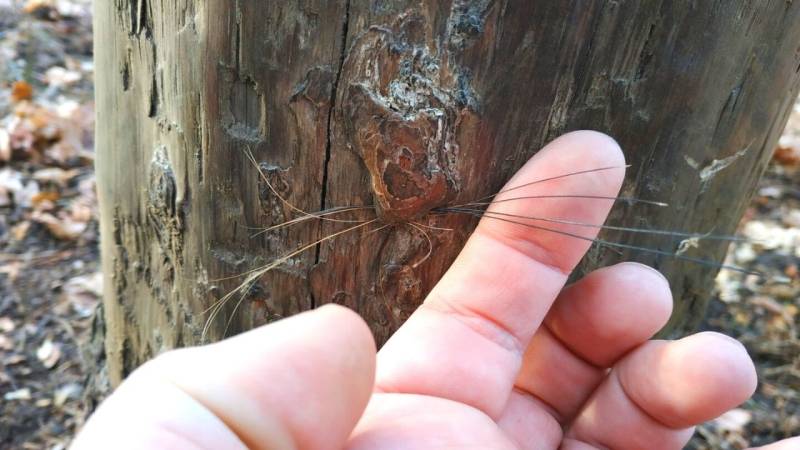
Be a part of the world out there
It is now up to you to deepen your knowledge, sharpen your skills, and strengthen your connection to nature. Go out, in sunshine or in a snowstorm, in the early morning or at dusk.
Every adventure begins with the first step.
And your next step takes you deeper into the world of the unknown, the wild, the true.
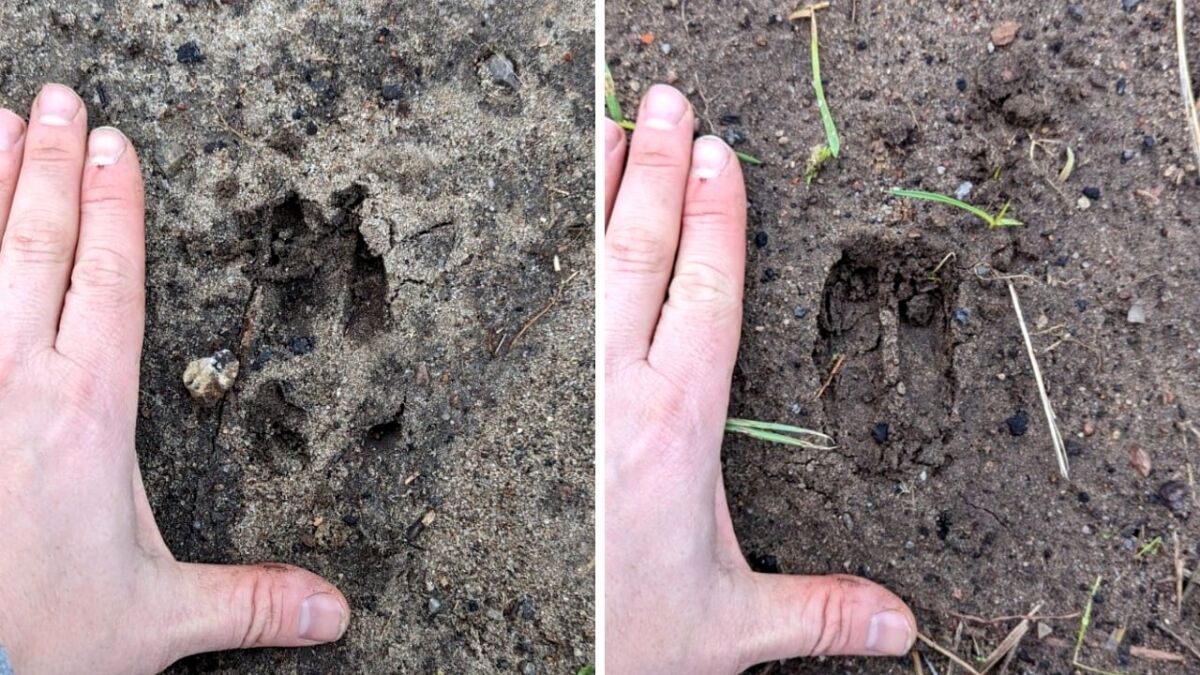
Questions and Answers about Animal Tracks in the Snow
What do roof tracks look like in the snow?
Fox tracks in the snow are robust and wide. They show five toe imprints on the front and back foot. The claws are long and strong, with the front claws further away from the toes than the back claws. The footprints are wider than they are long, almost rectangular and asymmetrical. The size is wide and robust: front tracks are 5.3-11.5 cm long and 4.4-7 cm wide, back tracks are 4.5-9 cm long and 3.5-5.7 cm wide.
What does a fox track look like in the snow?
Fox tracks are fine and precise. They show four toe pads and often visible claws. Sometimes delicate hairs from the imprints are visible. The tracks are oval and symmetrical, with large, heavily furred feet: front 4.8-7.3 cm long and 3.5-5.7 cm wide, back 4-6.3 cm long and 3-4.7 cm wide.
What does a marten track look like in the snow?
Marten tracks show five toes on each paw with visible claw marks, often only four toes are visible. The footprints are round to oval and often asymmetrical: Front 4–6.5 cm long and 4.5-6 cm wide, back 4.2-6.4 cm long and 4.2-5.5 cm wide.
What do squirrel tracks look like in the snow?
Squirrel tracks show 4 small toe imprints in the front (total of 5 toes) and 5 toes in the back. The claws are usually visible. The hind footprints are longer than the front footprints, creating an asymmetrical pattern. The tracks are small: front tracks are 3-4.8 cm long and 1.5-3.5 cm wide, back tracks are 3-6 cm long and 2.3-4.5 cm wide.
What do raccoon tracks look like in the snow?
Raccoon tracks resemble hand-like imprints with five well-spread toes and visible sharp claw marks. The raccoon does not have webbed feet or hair on its feet. Front tracks are almost like a small child's hand, while rear tracks are asymmetrical: front tracks are 4.1-8 cm long and 4-7 cm wide, more rounded in shape, while rear tracks are 4.8-10 cm long and 3.6-6.8 cm wide, more oval in shape.

My invitation to you: Take the trail!
So, put on your boots, pack your curiosity, and let's go. The tracks are already waiting for you out there - fresh in the snow, mysterious in the mud, hidden under falling leaves. They are waiting to be read, understood, and admired.
Download the most common animal tracks (Northern Europe) as a PDF here
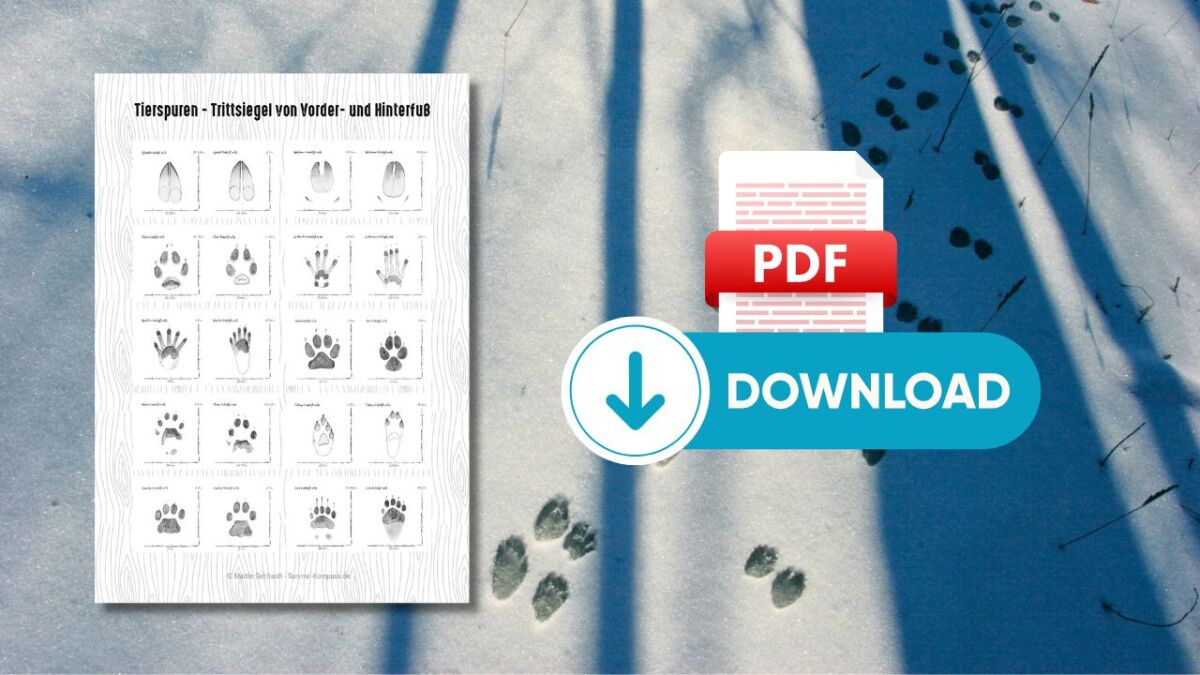
You are an explorer, a storyteller, a preserver of ancient skills. Share your knowledge, share your adventures, and become part of a community that values and lives this ancient art.
Here are two more recommendations:
👉 A guide on how to get started with tracking: From clues to good spots to book recommendations. Take a look at the guide with many pictures here: Learn tracking for beginners (with many picture examples)
👉 The Animal Tracks Quiz (in German). How many correct answers can you get? Do you know the footprints of our native animals?
Get ready, dive in, and become one with nature. An adventure awaits you, as old as time itself. Go out and read the signs that the forest has left for you.


Author of the guide
Martin Gebhardt
Hey, I'm Martin. On my blog, you will learn the basics and numerous details about living in the wild. I think survival, bushcraft and the good life in nature are the keys to happiness. Find me here on Instagram or on YouTube. You can find more about my mission on the About Me page.
Was this guide helpful?
35 people found this guide helpful.
5.00 out of 5 points (35 Ratings)
Comments (0)
This post may contain affiliate links. So if you click on the links and make a purchase, I will receive a small commission at no additional cost to you. Click here, to learn more about it.


